What is a VirtualBox
Oracle VirtualBox is a free and open-source hosted hypervisor that allows you to run different operating systems virtually on your host OS, which in this case is Windows 11. That means you can install operating systems like Ubuntu or Windows 10 without affecting your main system.
If you’re new to VirtualBox, the first thing to do is get yourself set up. Here’s how you go about that.
Before You Begin
Before you get started using VirtualBox there is a little bit of housekeeping needed to make sure your system is ready for it.
First up, if you’re on Windows 11, then your system should be using a CPU up-to-date enough to have no troubles running virtual machines. However, there may well be settings in your BIOS that you need to make sure are enabled first. Each BIOS is different, so you’ll need to refer to documentation for your hardware if you need to know how to get into it and how to navigate it.
Settings could well be labelled clearly as relating to hardware virtualization. Or, you could be looking for Intel VT-x or AMD-V. In any case, it’s worth checking first before you get further along.
You also need to ensure you don’t have Microsoft’s Hyper-V set up on your PC already. If you do, you’ll need to get rid of it before dabbling with VirtualBox.
Also read: How to Convert Virtual Machines from VMware to VirtualBox?
Installation Steps
Download VirtualBox
VirtualBox isn’t available in the Microsoft Store, but there are two different locations to get it.
- Open your favorite browser and search for “VirtualBox.”
- Now, click on the first link from virtualbox.org to access the download page.
- Click the download button for the Windows host to download the installation package.

However, if you use the Windows Package Manager (winget) you can also get it here. Enter the following command into your PowerShell window:
winget install oracle.virtualbox
Winget will go and fetch the installer and instantaneously run it for you.
Run the Installer
Once the .exe file is downloaded, click on it to start the installation.
Follow the setup wizard:
Click Next on the first setup window.

Leave the default installation location unless you have a particular reason to change it.

In the custom setup window, keep all options checked to create desktop icons and shortcuts, then click Next.

Complete Installation
- Click Yes when prompted to allow the installation.
- Wait for the installation to finish. If you receive a warning about installing device software, click Install.
- Once completed, ensure the checkbox to launch VirtualBox is checked and click Finish.

How to Create a Virtual Machine
Open VirtualBox
- After installation, launch VirtualBox.

Create a New Virtual Machine
- Click on the New button or go to Machine > New.

- You will need the ISO file of the operating system you wish to install (e.g., Ubuntu or Windows 10). Download the ISO from the relevant website.
Also read: 3 Methods to Upgrading to Windows 11: A Step-by-Step Guide
Key Points to Remember
- VirtualBox allows virtualization of multiple operating systems on a single host.
- Always download the correct version for your host OS.
- Keep default settings during installation unless specific changes are needed.
We hope these notes helped you understand the process of installing and setting up VirtualBox on Windows 11 effectively. Happy learning…
Windows 11 has had its fair share of ups and downs since its release. The OS is now much more stable and features numerous changes that seem to accommodate most users. Windows as a platform have always been versatile with the ability to create virtual machines, drives, hardware devices, and more.
This helps with internal testing, coding in different environments, or just some good old tinkering. If you’ve been looking to emulate or virtualize platforms on Windows 11 then VirtualBox is a great option for you. Let’s find out more about it!
What is VirtualBox?
VirtualBox is long-standing virtualization software that has been preferred by most users since its release. Currently published and managed by Oracle, VirtualBox allows you to virtualize x86 environments on your PC.
The tool not only supports Windows but also has dedicated clients for other platforms including the likes of Linux and macOS. If you’ve been looking to test tools, platforms, or code in a virtual environment then VirtualBox is a great option for you. You can create multiple virtual machines and boot them at will with the ability to install a custom OS on them.
You even have access to all basic drivers and the ability to use your native keyboard in host and virtualized environments.
How to use install and use VirtualBox on Windows 11: Everything You Need to Know
Here’s how you can use VirtualBox on your Windows 11 PC. There are a few hardware requirements that your setup will need to meet so that VirtualBox can function as intended. Additionally, there are a few things that you should keep in mind before proceeding with this guide.
The same have been listed below. Once you’ve prepared your setup as intended, you can use the guide below to install and set up VirtualBox on your PC.
Requirements:
Here are the minimum system requirements to run VirtualBox on a Windows 11 PC.
- CPU: x86 compatible hardware (Most modern Intel and AMD CPUs supported)
- RAM: Minimum requirement of Host OS (Windows 11: 4GB) + Minimum requirement of OS you wish to virtualize
- DiskSpace: Minimum space requirement by virtualized OS + 50 MB maximum for VirtualBox installation
- Windows 7: 16GB for 32-bit or 20GB for 64-bit
- Windows 8 & 8.1: 16GB for 32-bit or 20GB for 64-bit
- Windows 10: 16GB for 32-bit or 20GB for 64-bit
- Windows 11: 64GB or higher
- A supported OS for your virtual machine: Popular supported Operating Systems have been listed below
- Windows 10
- Windows 7
- Windows 8 & 8.1
- Windows Vista
- Windows XP
- Windows 2000
- Windows Server 2003, 2008 & 2012 (including R2)
- Windows NT
- Ubuntu Desktop
- Debian 6.0 to 8.0, 5.0, 4.0 & 3.1
- Fedora Core 1, 4, 5, 6
- Solaris 11
- Solaris 10 (5.08 and higher)
You can find a complete list of supported Operating Systems at this link if your OS isn’t listed above.
Preparation:
There are a few ways you will need to prepare before you start using VirtualBox. You might need to enable a few settings on your system and download a few files to help you along the way. Use the sections below to help you along with the process.
1. Operating System (OS)
Firstly, you will need the OS you wish to install on your virtual machine. We recommend you download the same beforehand to help you along with the process. We have listed download links for popular operating systems below to get you started.
- Windows 7 | Download Link
Note: This is a web archive link that might stop working after some time.
- Windows 8.1 | Download Link
- Windows 10 | Download Link
- Ubuntu desktop | Download Link
Download and keep your OS ISO handy. We will require this during the initial VirtualBox setup to boot and install the OS from the same.
2. Free Space
You can run out of free space pretty easily when using VirtualBox. If you plan on virtualizing for a long time then it is recommended you create enough free space on your disk drive. While VirtualBox creates and manages its own virtual disk space depending on the size of your OS and contained files, you should create a separate partition if possible just to be safe.
Do keep in mind that Page files can also interfere with virtual folders used by VirtualBox as virtualized disk drives. If you’re running out of space then turning off the Page file for the current disk might be a good idea.
3. Drivers (optional)
VirtualBox is bundled with most generic drivers and the ability to install extension packs that offer additional choices and capabilities. While ideal for most systems, some proprietary hardware or components might need their drivers to be manually installed.
This includes custom monitors, USB hubs, unsupported iGPUs, and more. If you have any such components we recommend you keep their drivers handy. This way you can install them and get your setup up and running in case VirtualBox drivers do not support your components.
How to install and get started with VirtualBox
Now that you’re prepared and ready to virtualize, here’s how you can use VirtualBox on your PC. Follow the steps below to help you along with the process.
Step 1: Download and install VirtualBox
- VirtualBox | Download Link
Click the link above to visit the VirtualBox download page in your preferred browser. Now click Windows hosts to download the latest package of VirtualBox for Windows.
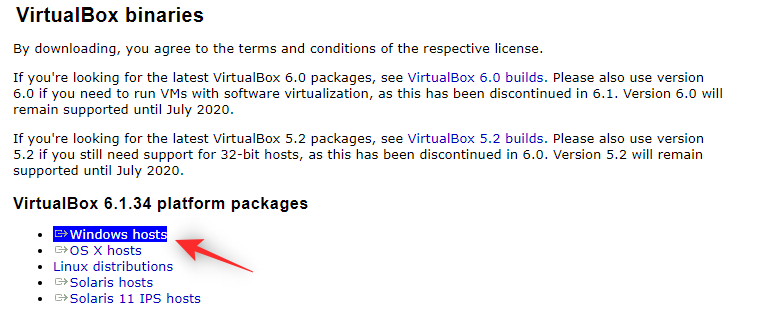
Save the setup in a convenient location on your local storage. Once downloaded, double click and launch the same on your PC.
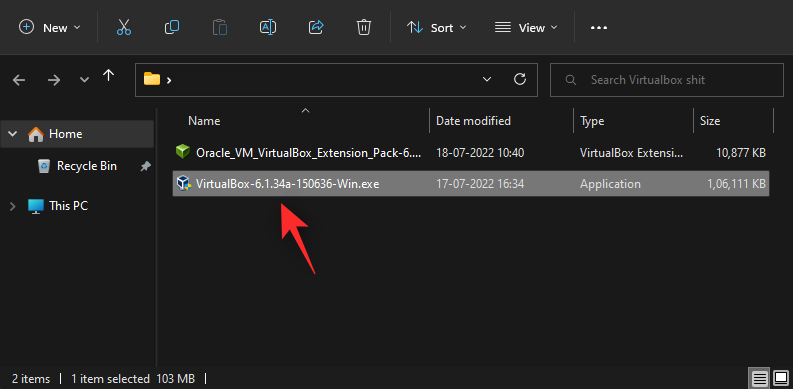
Click Next to initiate the setup.
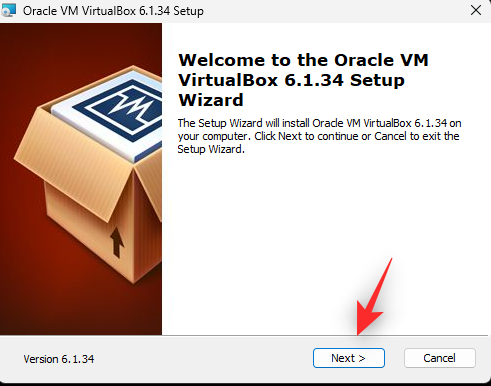
Click Browse and choose an installation directory for VirtualBox on your PC as needed.
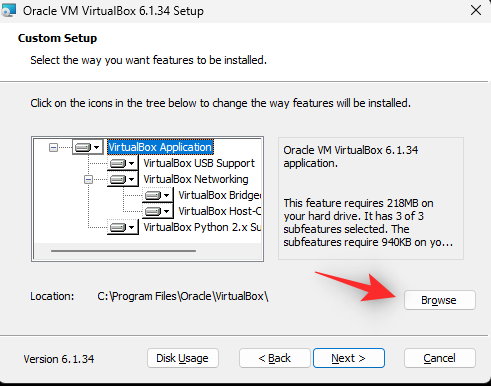
Note: This will be the VirtualBox installation directory and not the space used by your virtual machine unless you specify the same.
Click Next once you’re done.
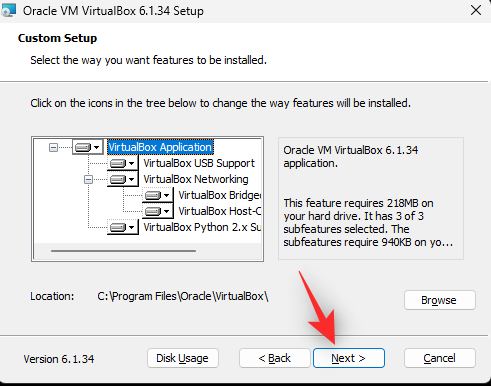
Check the following boxes depending on where you wish to place VirtualBox shortcuts and context menus. We recommend you leave these at their default values if you’re unsure of what to select.
- Create start menu entries
- Create a shortcut on the desktop
- Create a shortcut in the Quick Launch Bar
- Register file associations
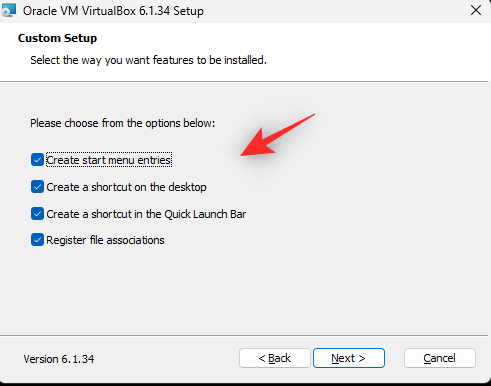
Click Next.
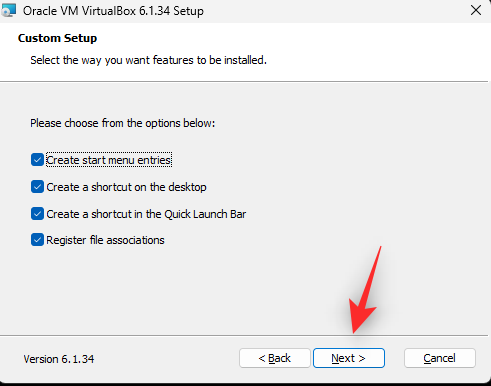
You will now be notified that the internet will be disconnected for a while during the installation process. This might be a good time to pause any ongoing downloads in the background. Click Yes once you’re ready.

Click Install to confirm your choice.
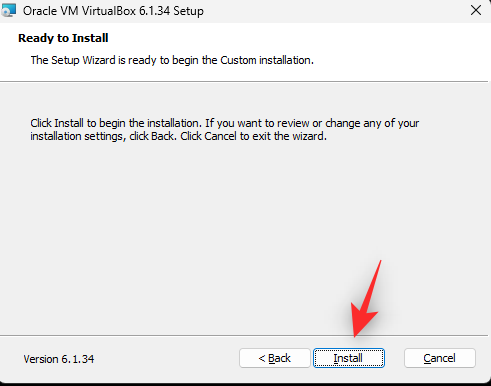
Once the setup is completed, uncheck the box for Start Oracle VM VirtualBox n.n.nn after installation.
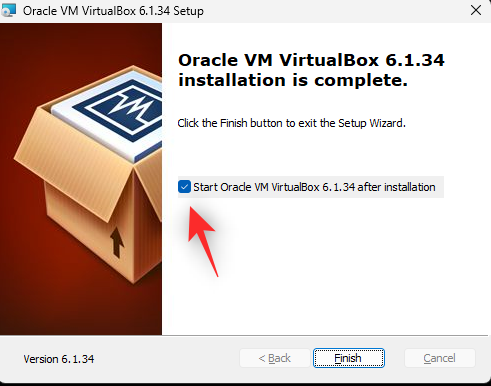
Click Finish.
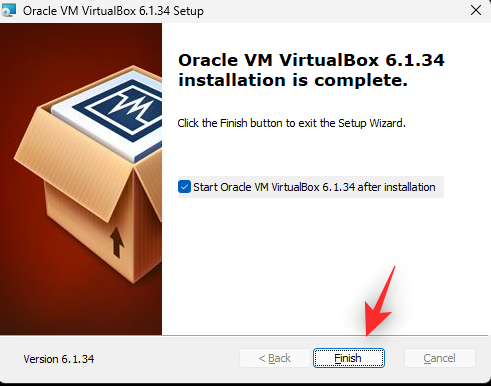
And that’s it! VirtualBox has now been installed on your PC. You can now follow the next step to create a new virtual machine using VirtualBox on your PC.
Step 2: Create your Virtual Machine & install the extension pack
Here’s how you can create your first virtual machine in VirtualBox.
Start by launching VirtualBox using your desktop or start menu shortcut.

Click New.
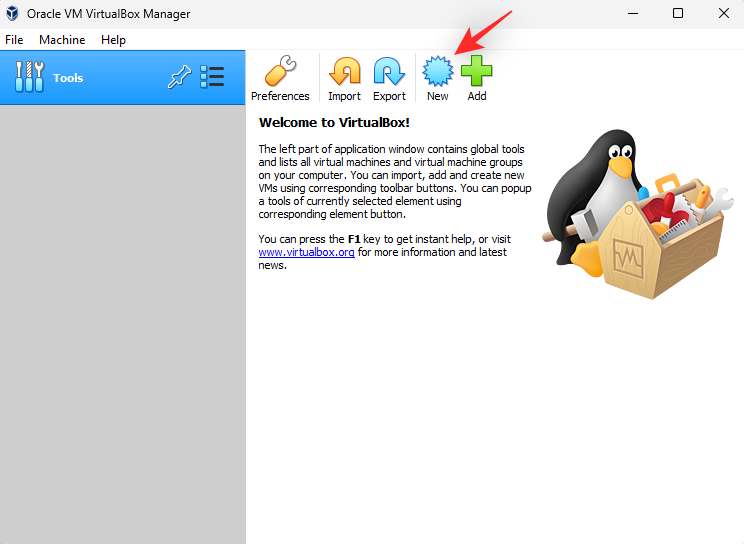
Now enter a name for your new virtual machine at the top. We recommend using a name that helps you easily identify the machine as well as the OS installed on it. We will be using Windows 10 for this guide.
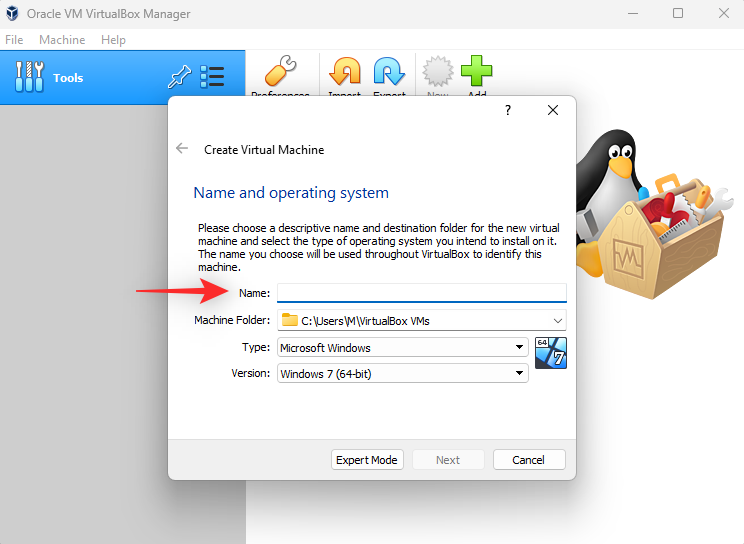
Now click the drop-down menu for Machine folder and select Other.
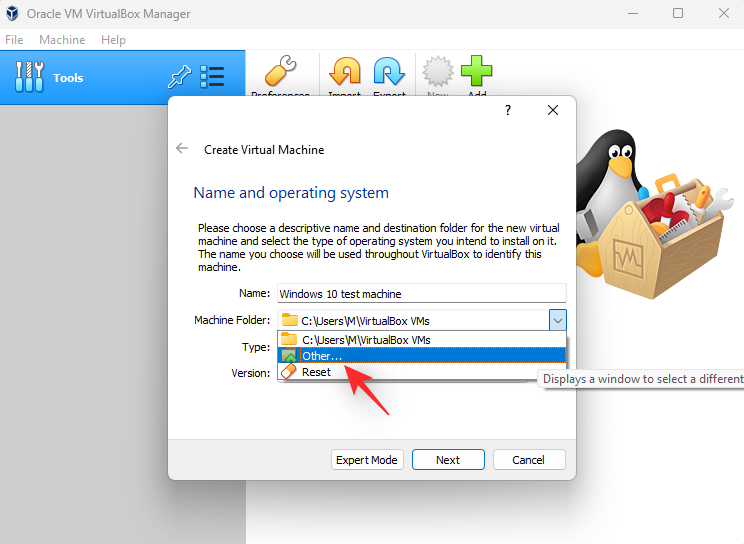
Choose a location where your virtual machine will be created. This space will be used by your virtual machine to install the OS as well as additional tools as needed. If you created a dedicated partition for the same, this is where you should select the same. Click Select Folder once done.
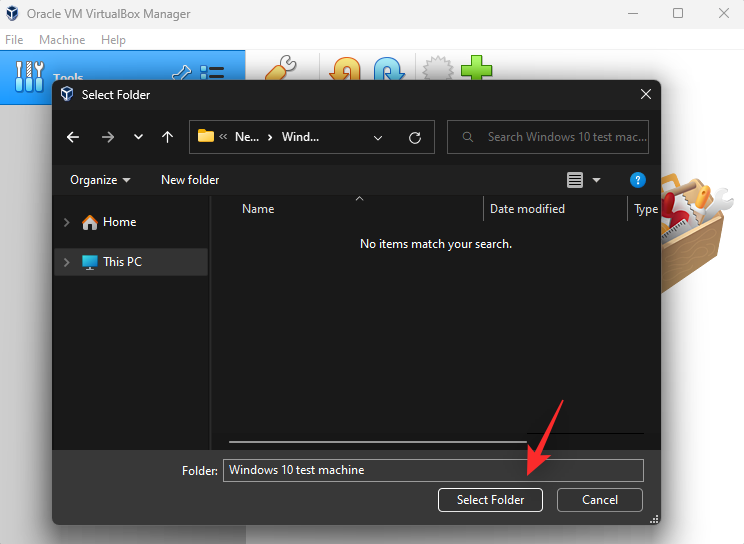
Click the drop-down menu for Type and select your OS. We will select Windows for this guide.
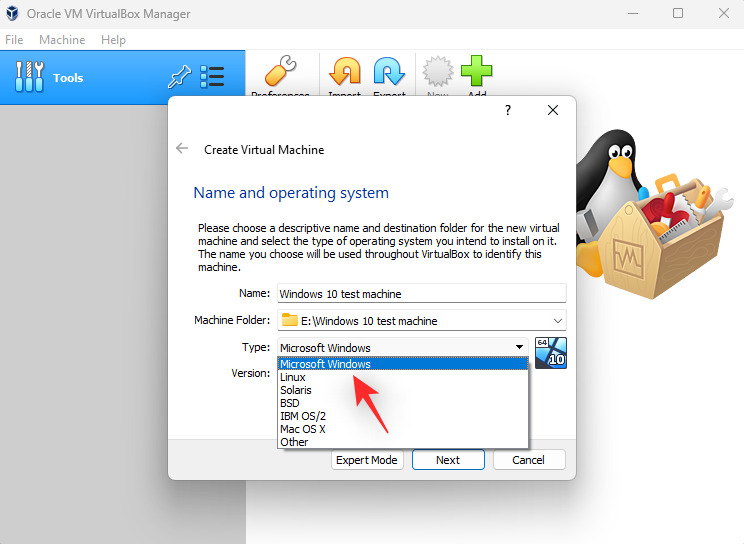
Subsequently, click the drop-down menu for Version and select the appropriate OS version you wish to install on the new Virtual Machine.
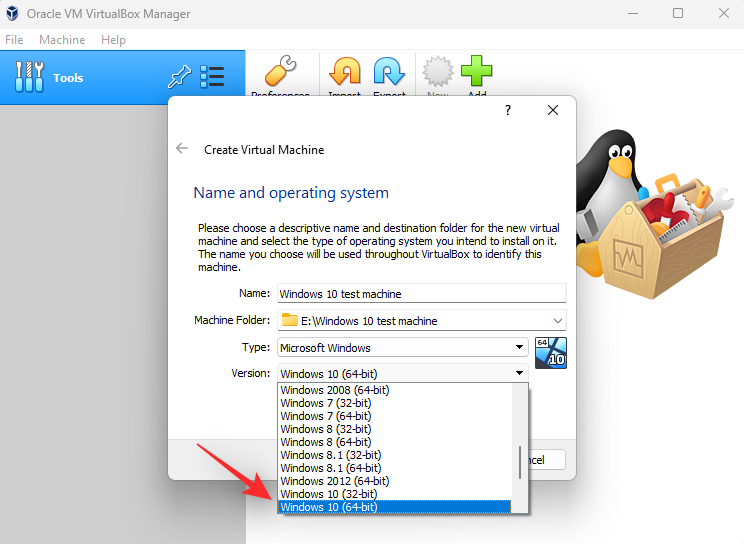
Click Next once you’re done.
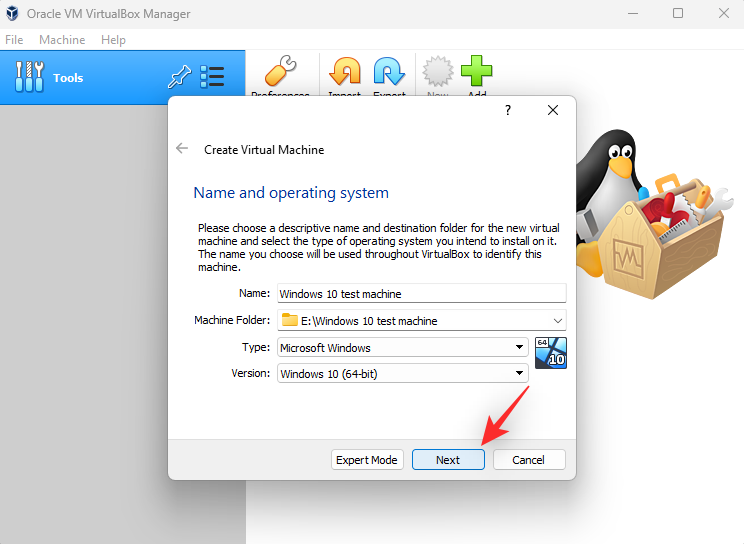
You will now be shown the available RAM on your PC. This will be shared by your Virtual Machine whenever it is running. Use the slider to adjust the amount of RAM you wish to assign to your virtual machine. VirtualBox will have automatically selected the recommended amount of RAM needed by the selected OS.

Once you’re done, click Next.
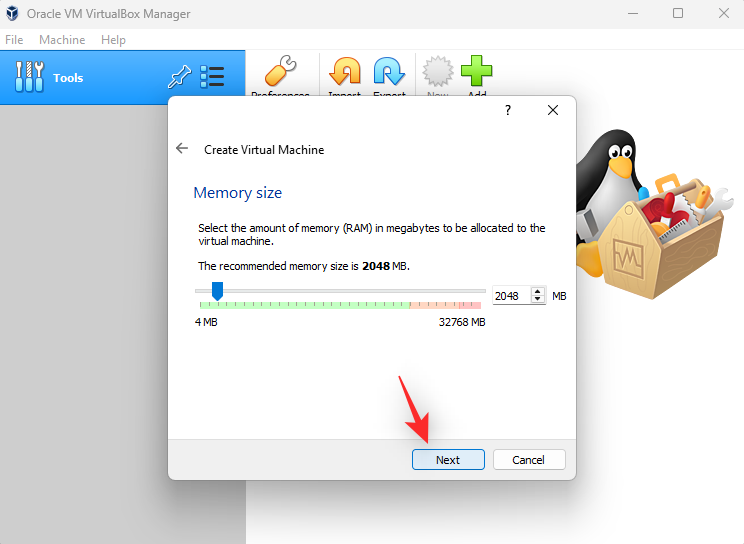
You will now be asked if you wish to add a virtual hard drive. If you plan to use the OS as is, then it is a good idea to add a virtual hard drive. However, if you wish to split your storage or try a dual boot setup then you can choose to do so later on when installing your OS as needed. Choose one of the options below depending on your preferences.
- Do not add a virtual hard disk
- Create a virtual hard disk now
- Use an existing virtual hard disk file

Click Create.
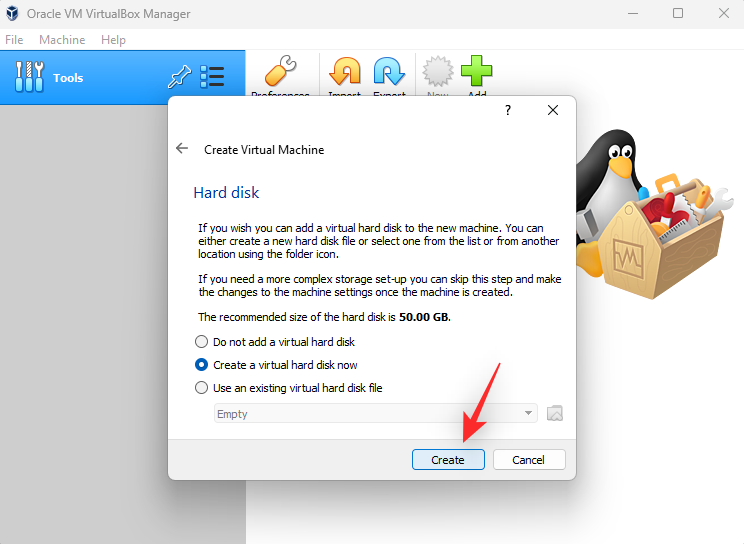
You will now be asked the type of virtual hard drive you wish to create. You can use the VDI option if you wish to use the space only with VirtualBox. If you wish to use it with other emulators or virtualization software then you can select one of the following options depending on its support.
- Virtual Hard Disk (VHD)
- Virtual Machine Disk (VMDK)
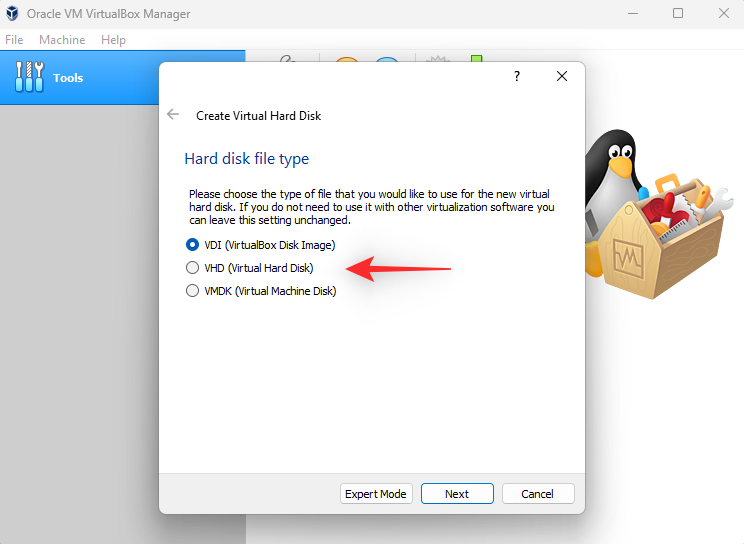
Click Next once you’ve made your choice.
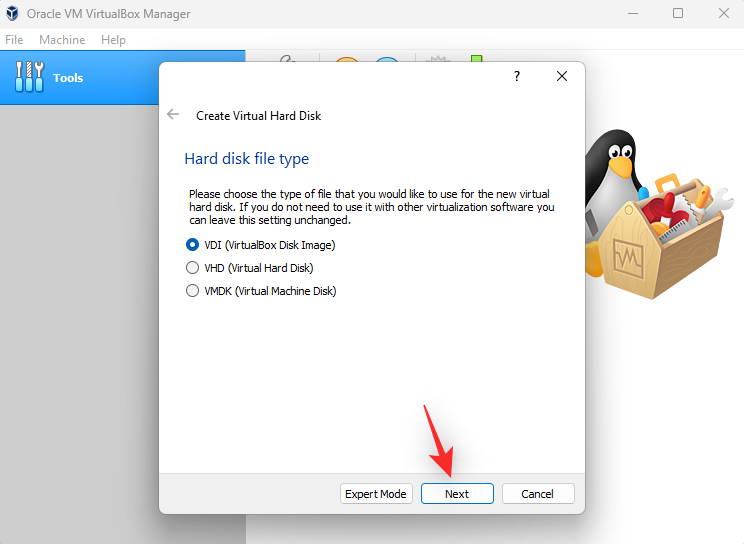
Now choose one of the following options depending on the type of disk you wish to create.
- Dynamically allocated: The virtual disk will use up space on your physical disk as it fills up.
Note: While space will be used as needed, space can not be reclaimed once freed up.
- Fixed-size: A fixed size will be assigned to your virtual drive. It won’t be able to grow or reduce in size later on.
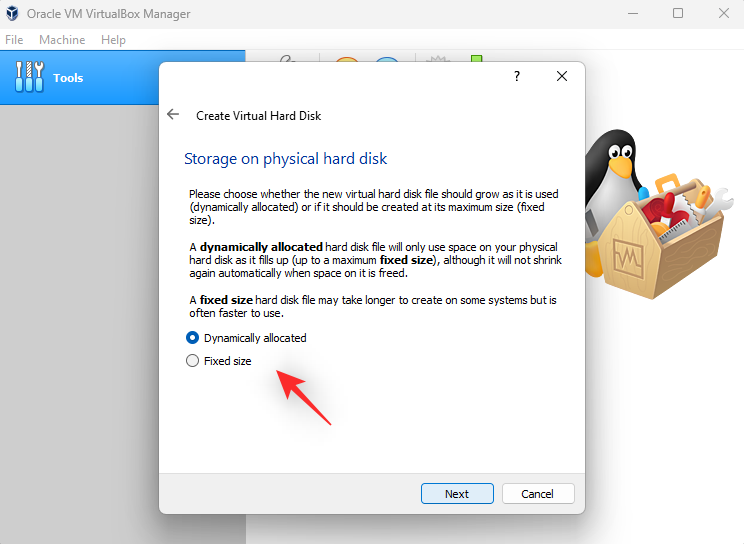
Click Next once you’ve made your choice.
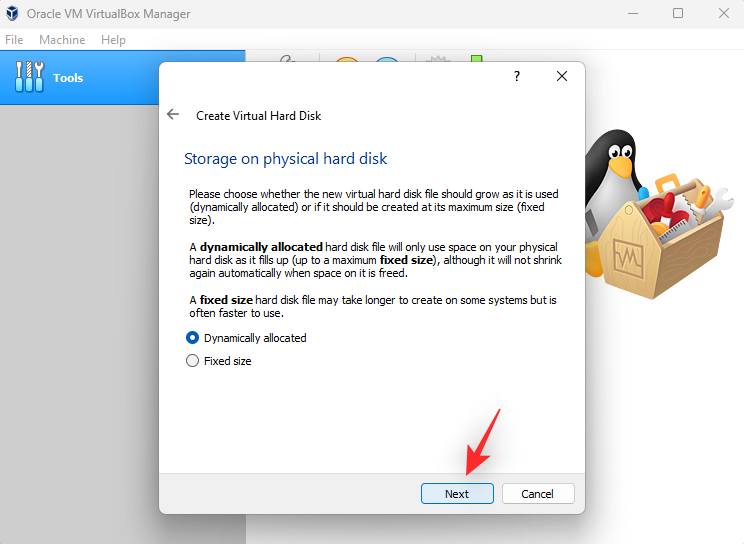
Click the folder icon on the next page.
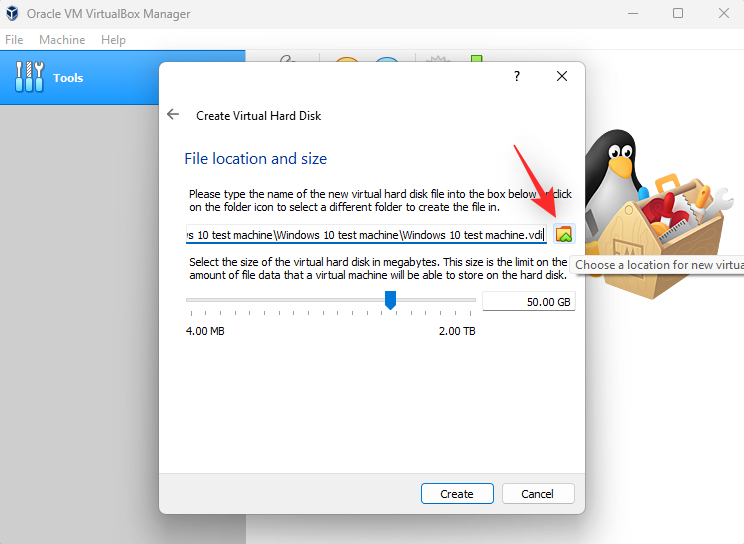
Now choose a location for your virtual hard drive on your system. Click Save.
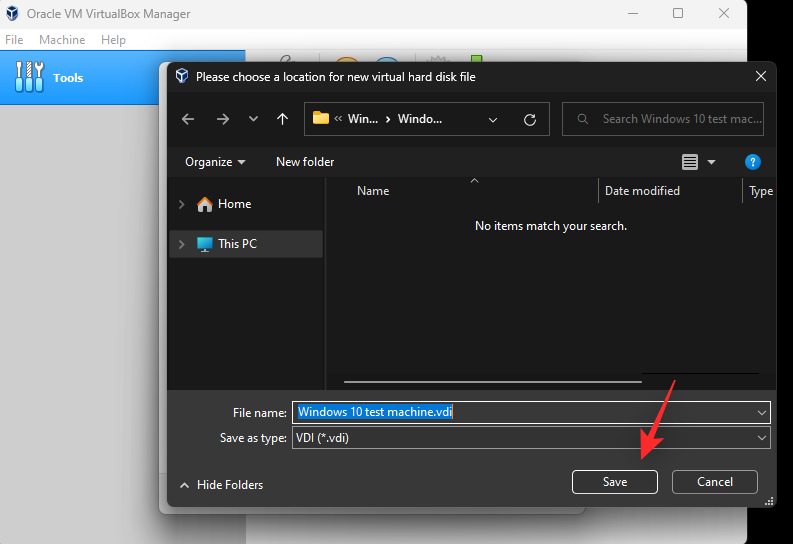
Note: Do not change the file extension for your virtual hard drive when choosing a location.
Now use the slider at the bottom to choose the initial space you wish to assign to your virtual hard drive if you chose Dynamically allocated earlier. This will be the fixed size of your virtual hard drive if you chose the same.
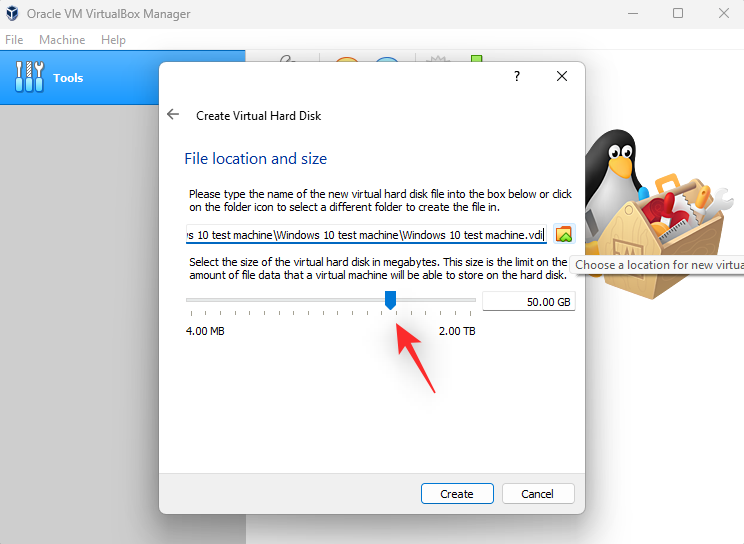
Once done, click Create.
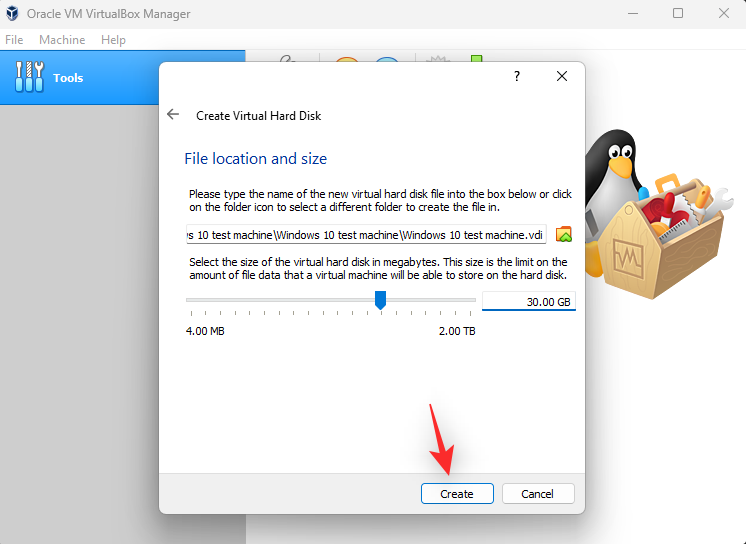
You will now have created your new virtual machine. We will now install the extension pack. Start by downloading the extension pack on your PC using the link below.
- VirtualBox Extension Pack
Switch back to VirtualBox. Click Tools on your left and then Preferences at the top.
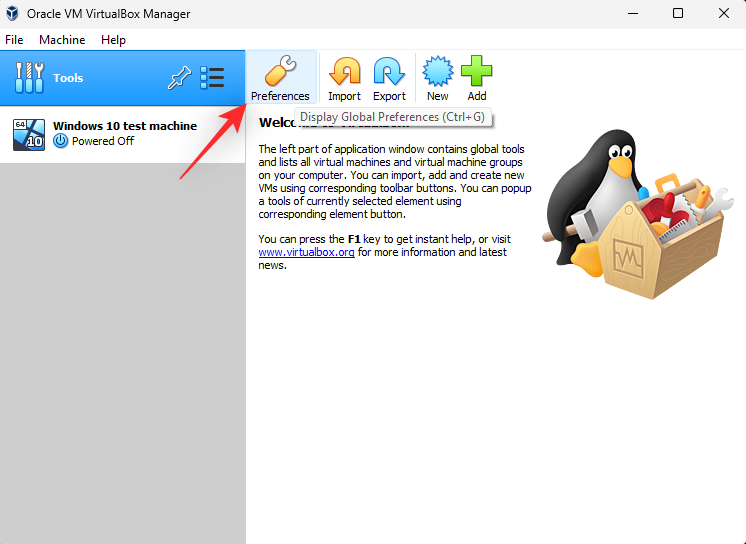
Now click Extensions on your left.
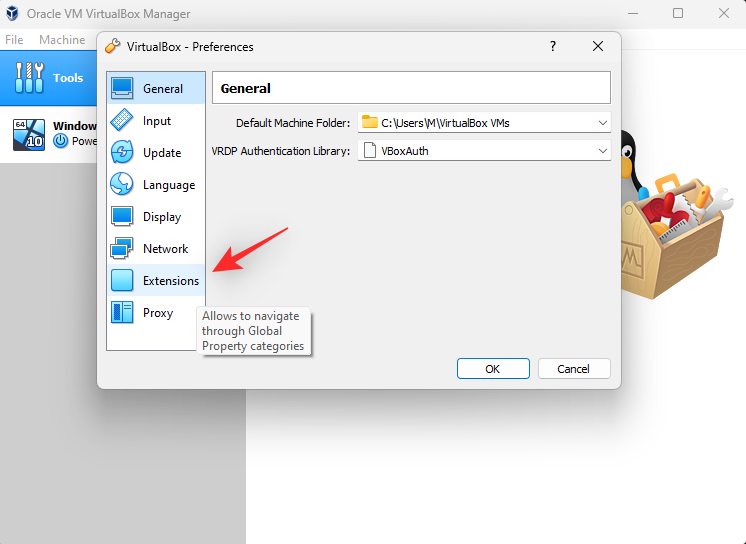
Click the Add extension icon.
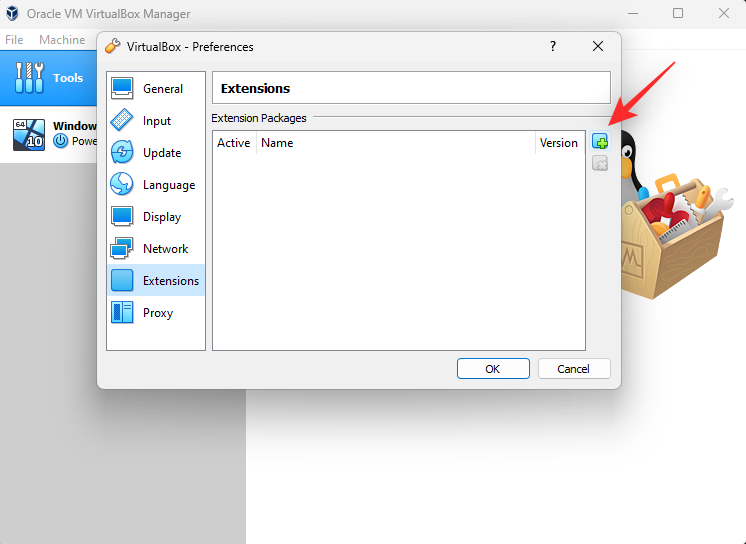
Select the extension pack we downloaded earlier.
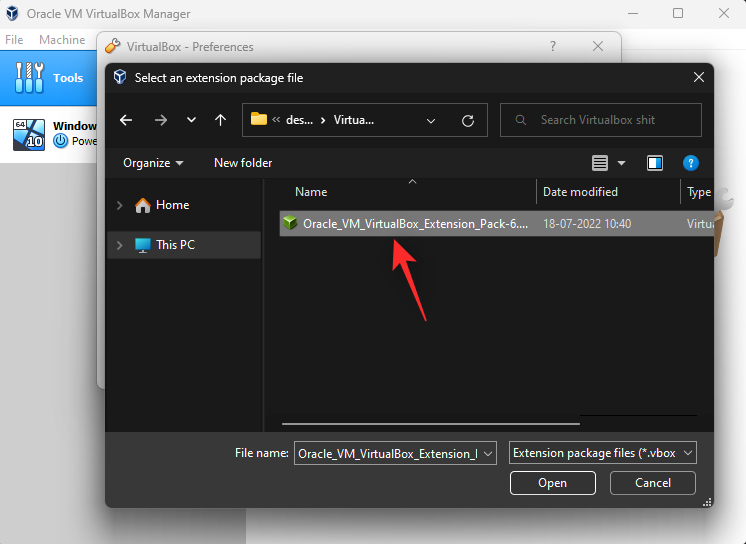
Click Install.
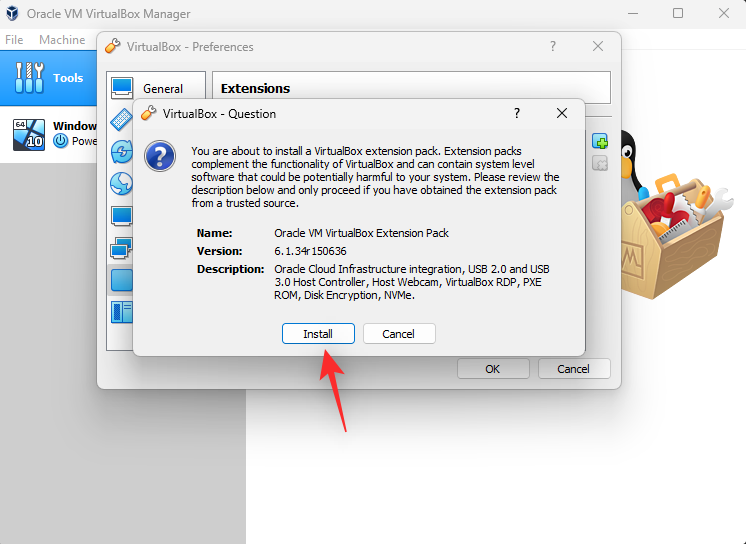
Scroll to the bottom of the license agreement and click I Agree once available.
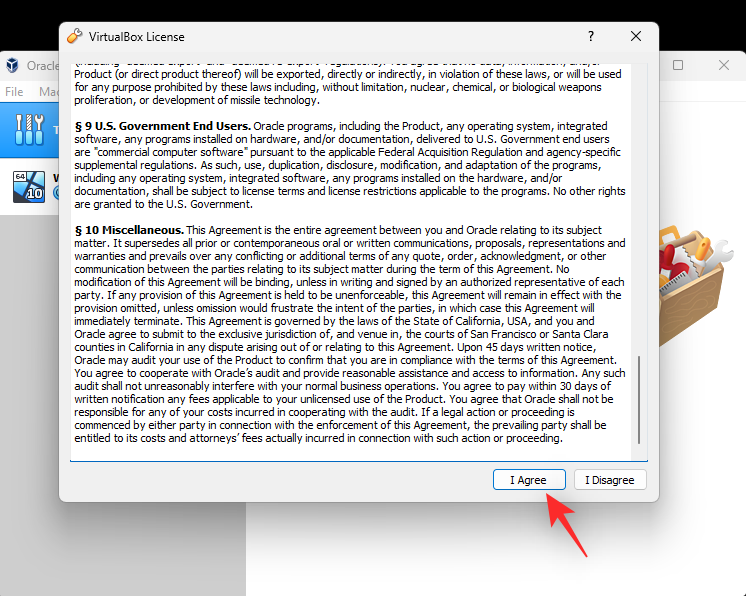
Once installed successfully, click OK.
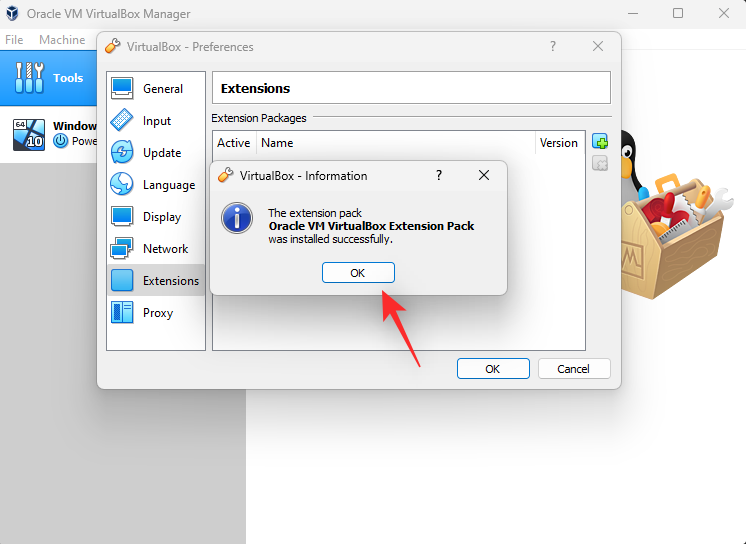
Click OK again.
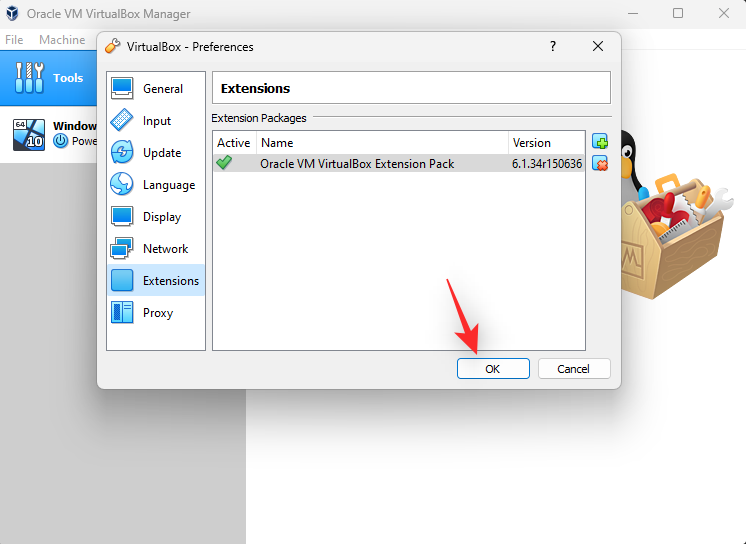
You can now use the step below to install the OS on your new machine.
Step 3: Install your OS on your Virtual Machine
Installing an OS on your new Virtual Machine should be the same as installing one on any setup. We will be using Windows 10 as an example for this guide, but the steps below should help you configure other operating systems as well. Let’s get started.
Launch VirtualBox on your PC and click and select the desired machine from the left sidebar.

Click Settings.
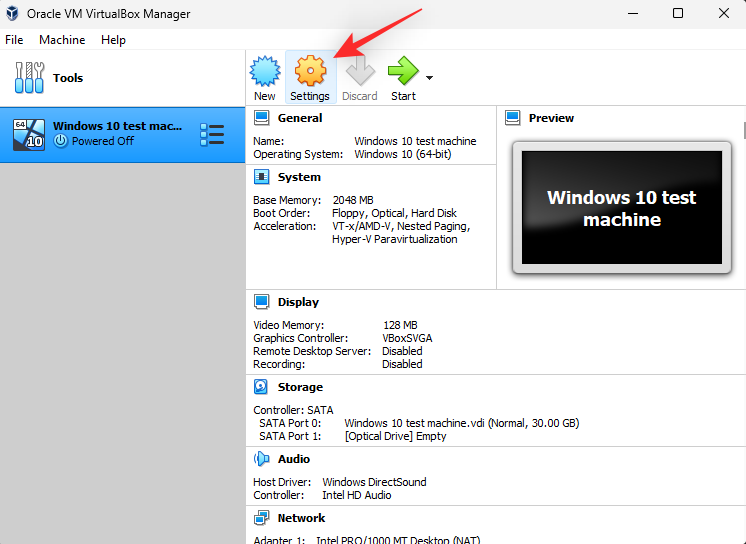
Click Storage on your left.
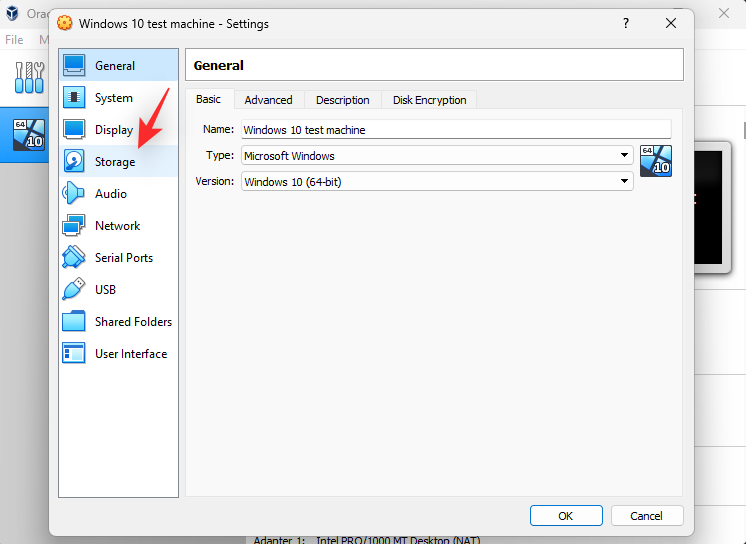
Now click and select the Disk icon below your virtual drive.
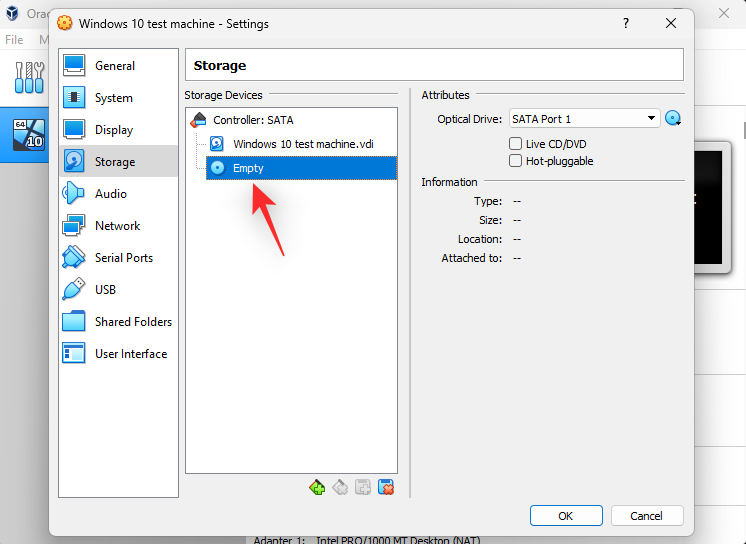
Click the Disk icon beside the default SATA port on your right.
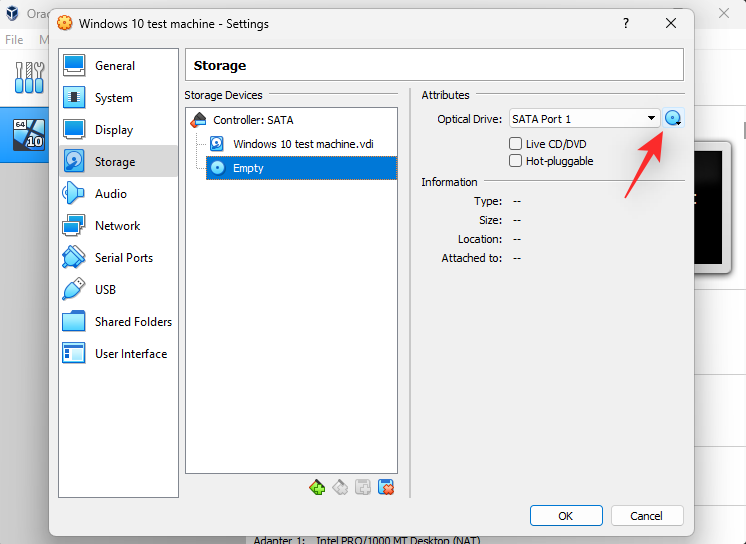
Click Choose a disk file.
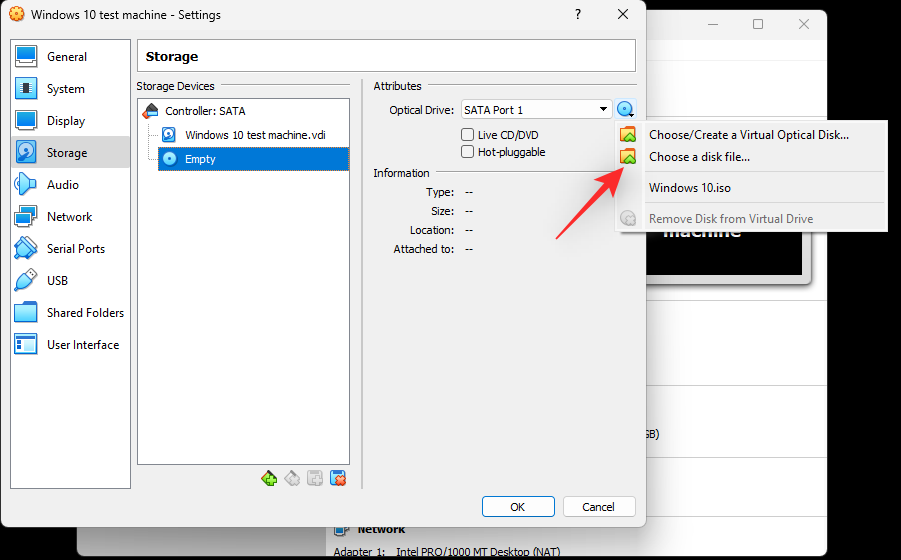
Now select the operating system ISO you downloaded earlier from your local storage.
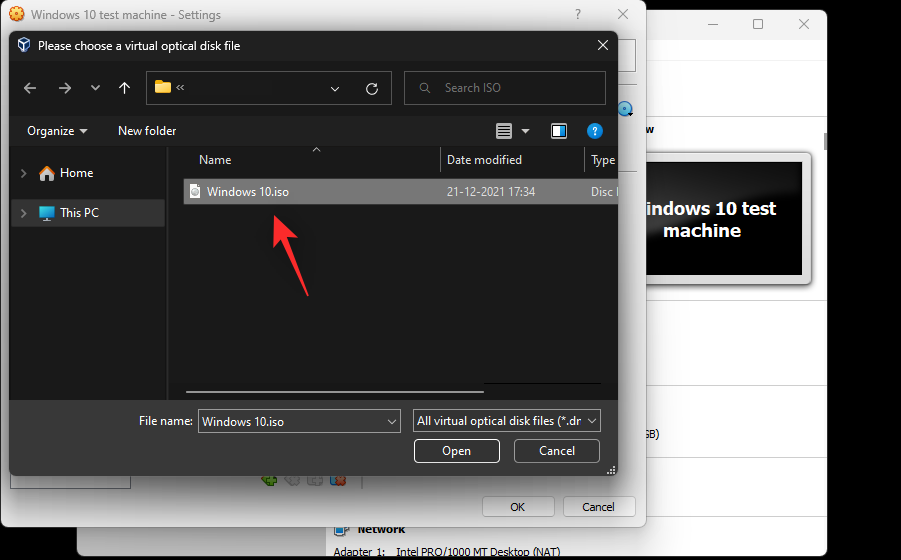
Once done, click OK.
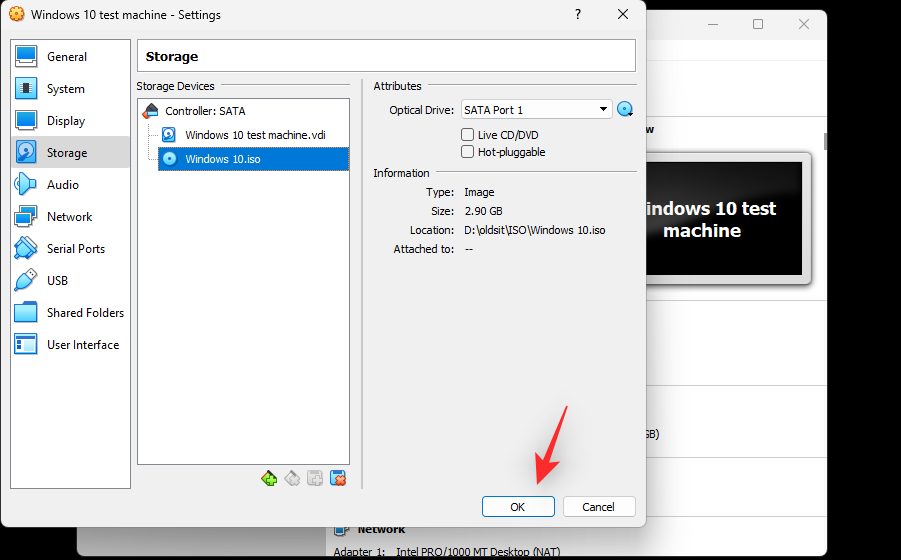
You will now be taken back to the home page. Click Start at the top.
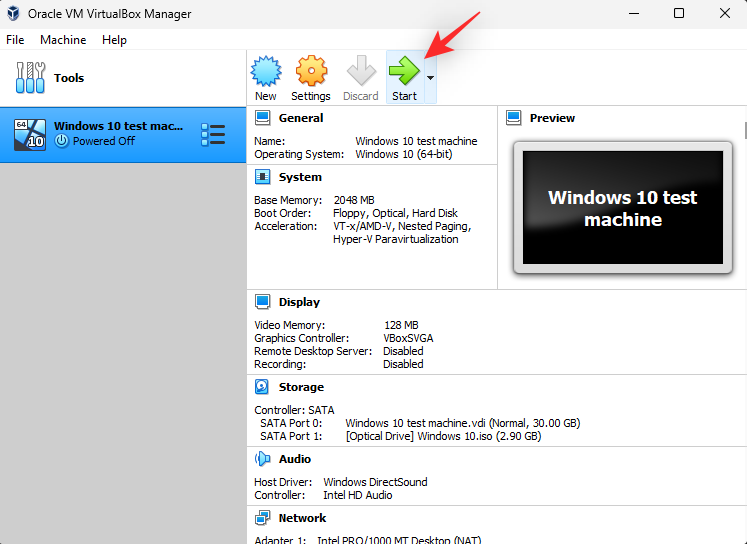
The virtual machine should now automatically boot on your system using the downloaded ISO. If not, use F12 to enter the boot menu and select the same.
Now that your virtual machine is set up in VirtualBox here’s how you can use and troubleshoot the same in case you face any issues.
1. Powering On & Off
You can Power On your virtual machine by selecting the same on the VirtualBox homepage and then clicking Start.

You can click the drop-down menu to access the following startup options for your virtual machine.
- Headless start
- Detachable start
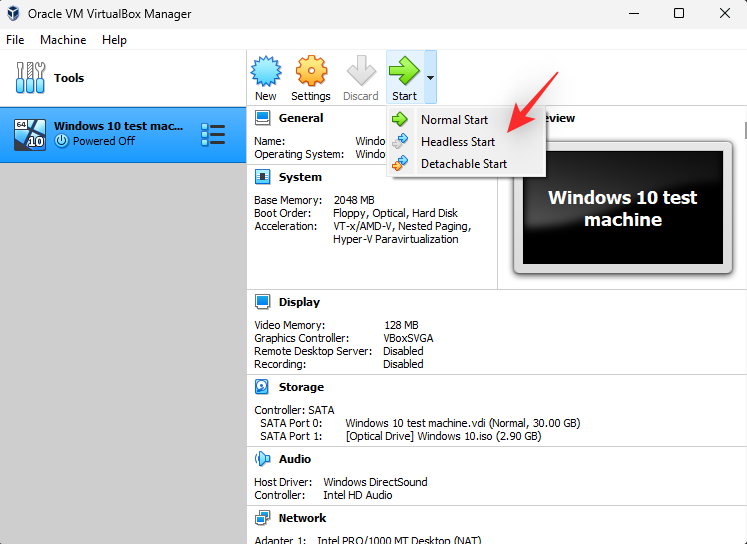
To power off a machine, you can click File > Close.
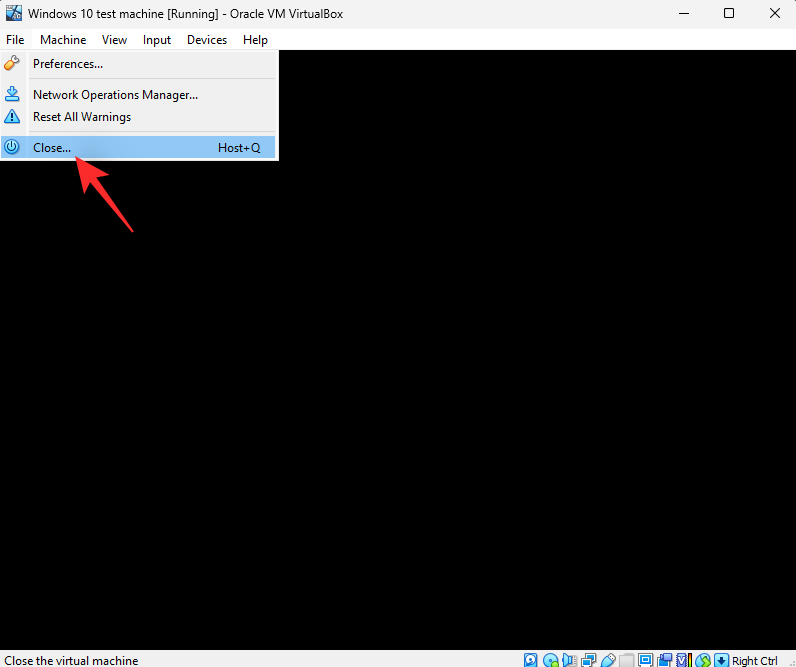
You can now select one of the following options depending on your preferences.
- Save the machine state: This will simulate hibernation and start your machine from its current state once you power it on in the future.
- Send the shutdown signal: This will be the shutdown signal to the virtual machine. The OS can then respond based on its default power settings.
- Power off the machine: This will simulate a manual power off for your virtual machine.
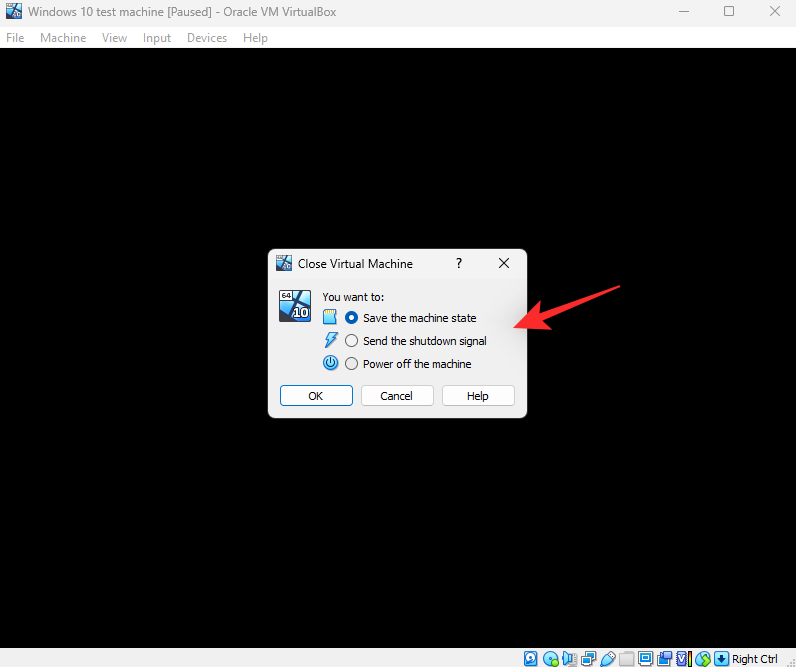
Click OK once you’ve made your choice.
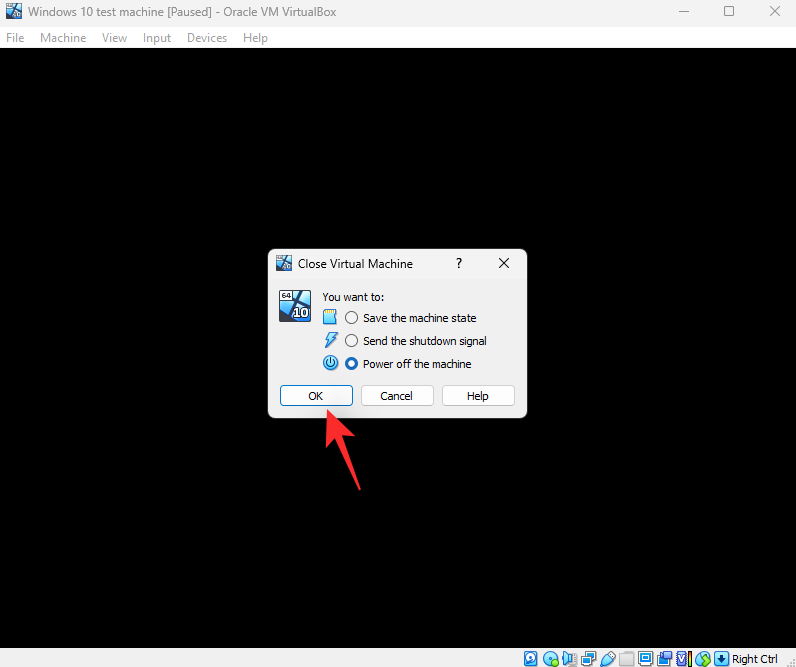
You can also use the Host + Q keyboard shortcut to access the Power Off options. The host key can be customized on your preferences. By default, Right Ctrl will be the host key for every virtual machine created in VirtualBox.
2. Managing the resources
Let’s see how to manage resources like RAM, Video Memory, Graphics controller, Storage devices, Displays, Audio Devices, Network Interfaces, and Serial Ports.
There might be times when you wish to assign more resources to your virtual machine. Here’s how you can do the same in VirtualBox.
Launch VirtualBox on your system and click the concerned virtual machine on your left.
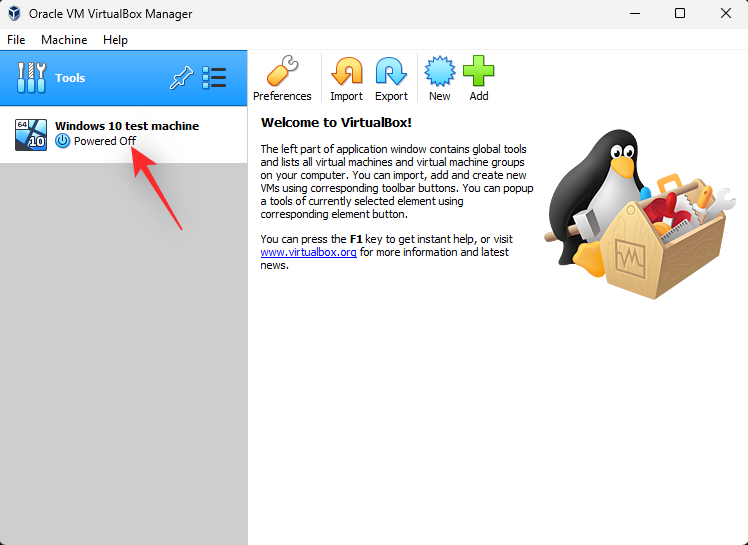
Click Settings.
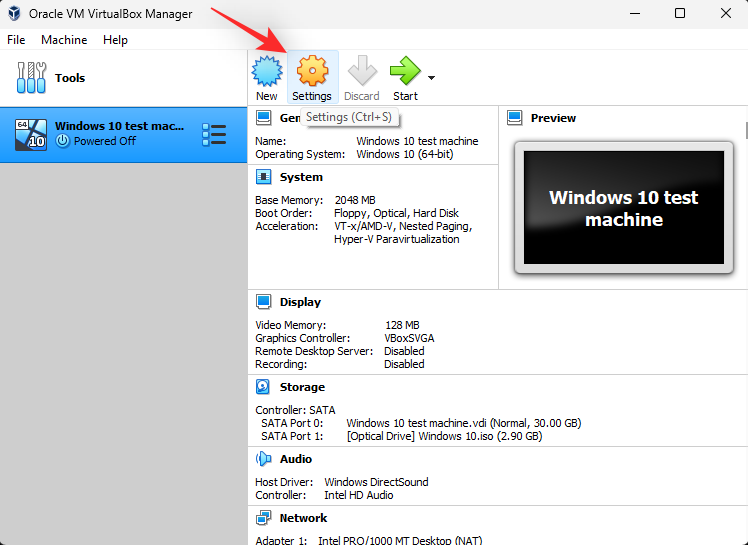
Click System.
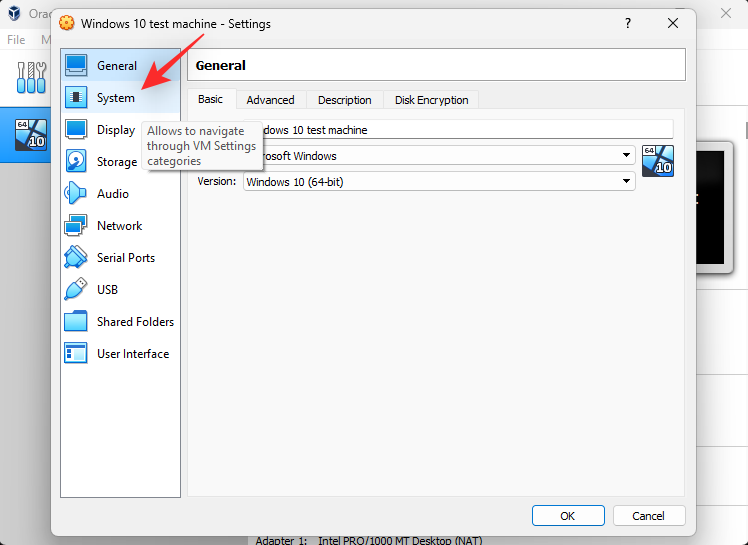
Use the Base Memory slider to increase or decrease the amount of RAM assigned to your virtual machine.

Use the Boot Order section to manage your boot devices. Check the boxes for boot devices to include them or uncheck the same to exclude them.
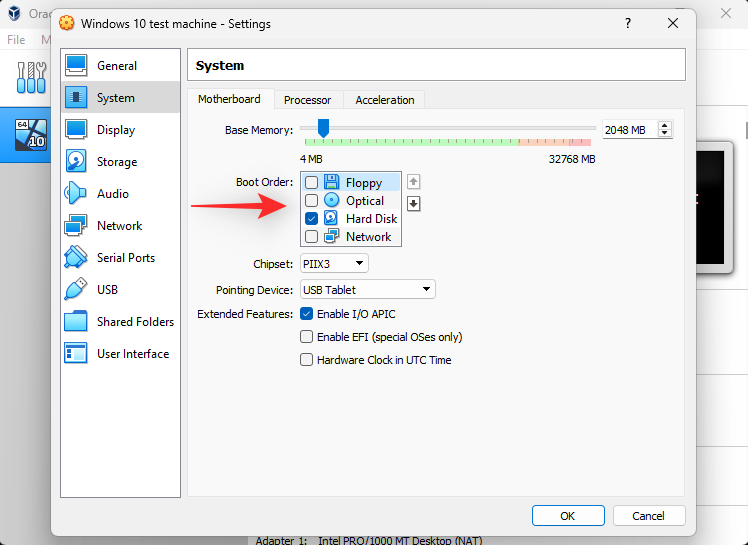
You can also re-order your devices to change the boot order. Click and select a device.

Now use the Arrows on your right to move it up or down in the boot order as needed.
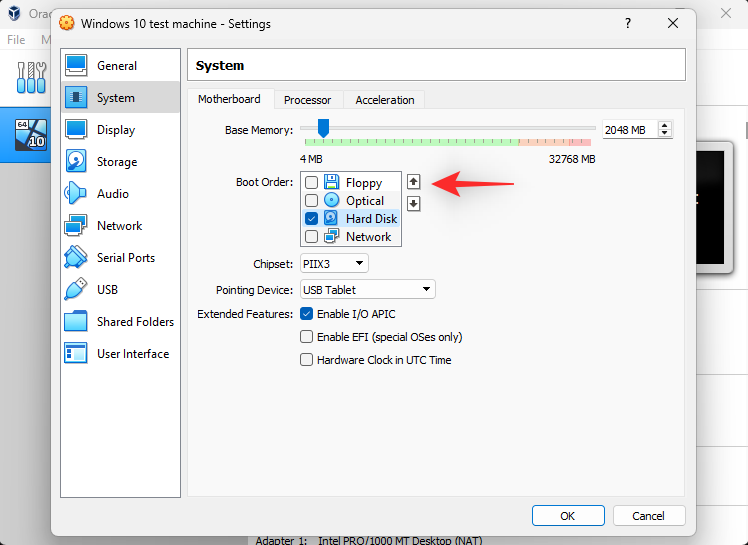
If your OS does not support touch input, you can select a mouse input using the drop-down menu for Pointing Device.
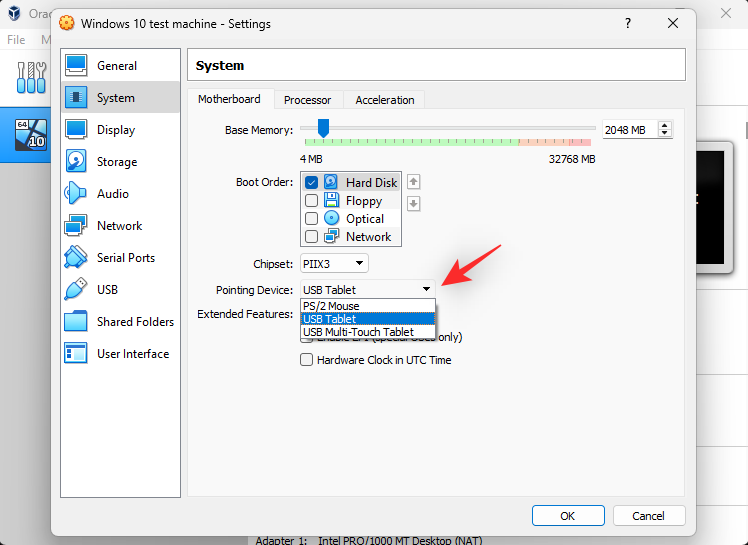
Click and switch to the Processor tab now.
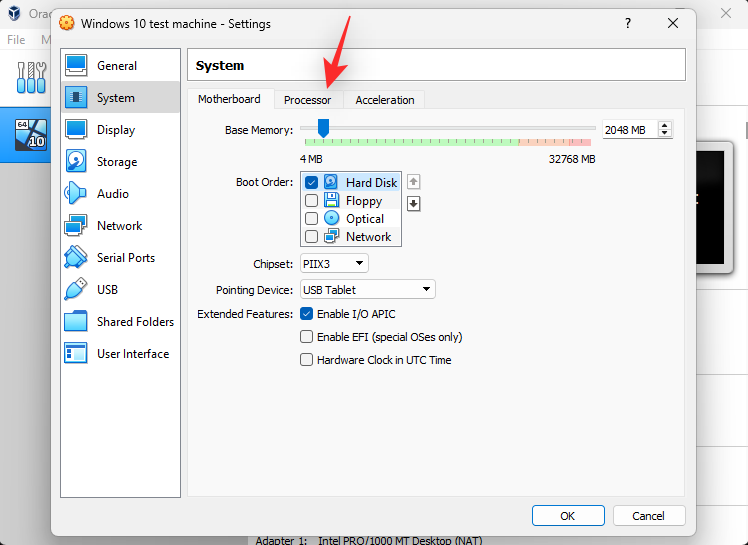
Use the slider for Processor(s) to increase or decrease the number of CPU threads used by your virtual machine. If you have a muli-CPU setup then you should have different sliders for each of your CPUs in this section.
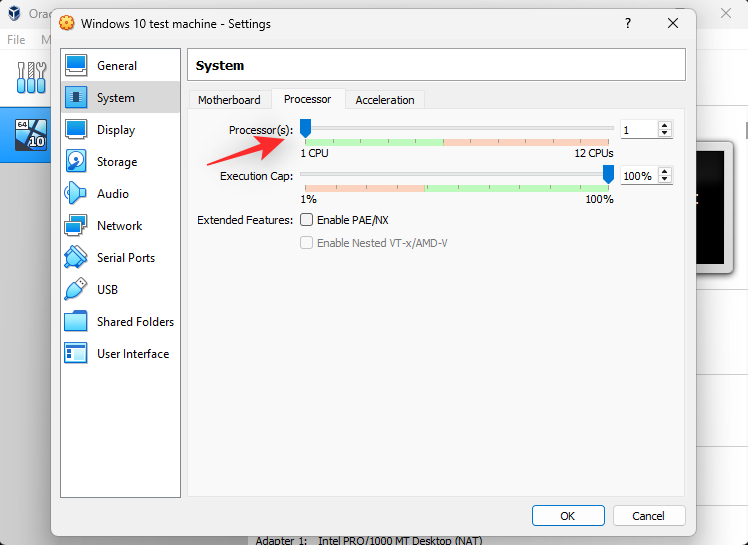
You can use the Execution cap slider to dictate the CPU cap on your assigned threads.
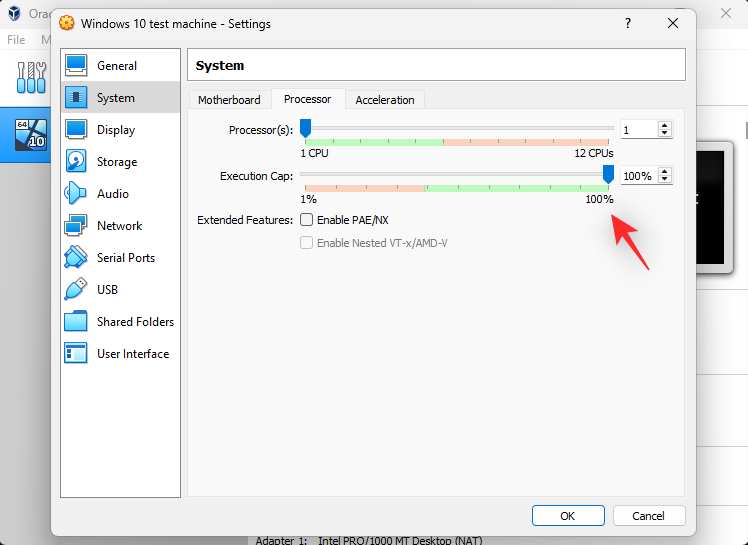
Click and switch to the Acceleration tab.

You can select your Paravirtualization Interface in this tab. This choice will help your Guest OS kernel work as intended with additional capabilities depending on your hardware. Here are the choices at your disposal and the recommended OS for each choice.
- Minimal: Required mostly by Mac OS X operating systems.
- KVM: Linux Hypervisor interface. Recommended choice for Linux operating systems.
- Hyper-V: Microsoft’s hypervisor interface, recommended for most Windows guest OS.
- None: Turns off the paravirtualization interface
- Default: This is the default option before you make your custom choice. It allows VirtualBox to select the appropriate paravirtualization interface depending on the OS you are using.
- Legacy: This option is applicable when you’re using older versions of VirtualBox to install and use deprecated operating systems.
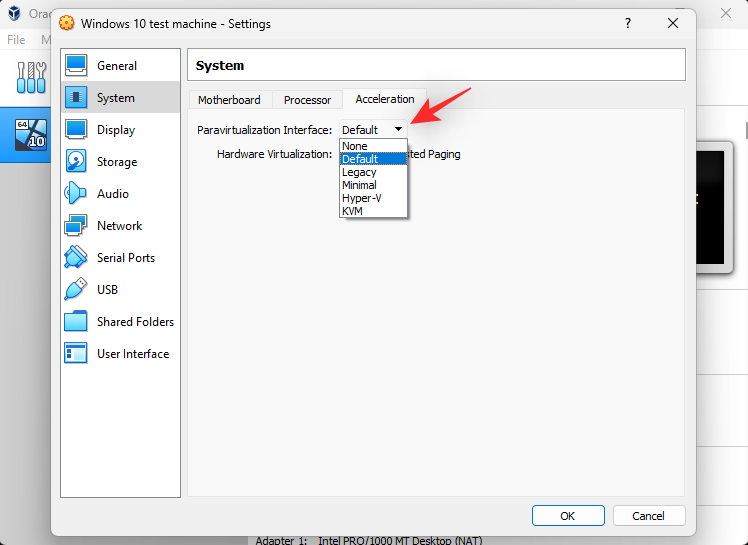
Once done, click Display on your left.
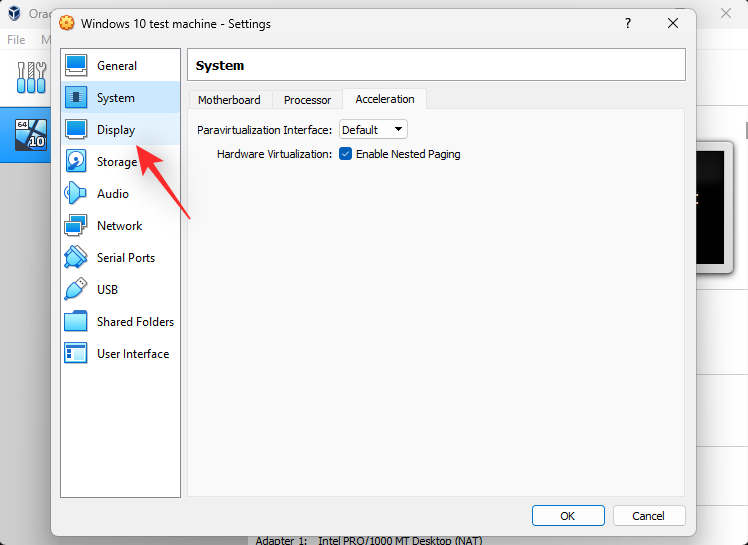
You can adjust the amount of Video Memory used by your virtual machine by adjusting its slider at the top.
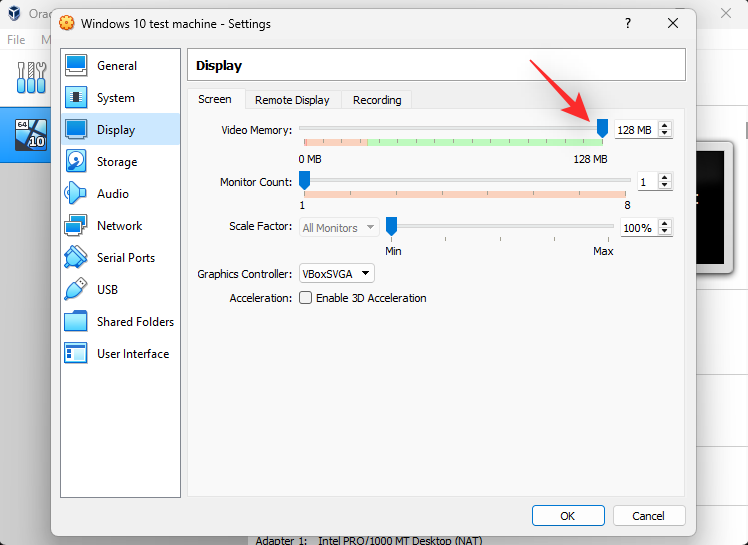
If you have a multi-monitor setup, you can increase or decrease the ones used by your virtual machine using the slider for Monitor Count.
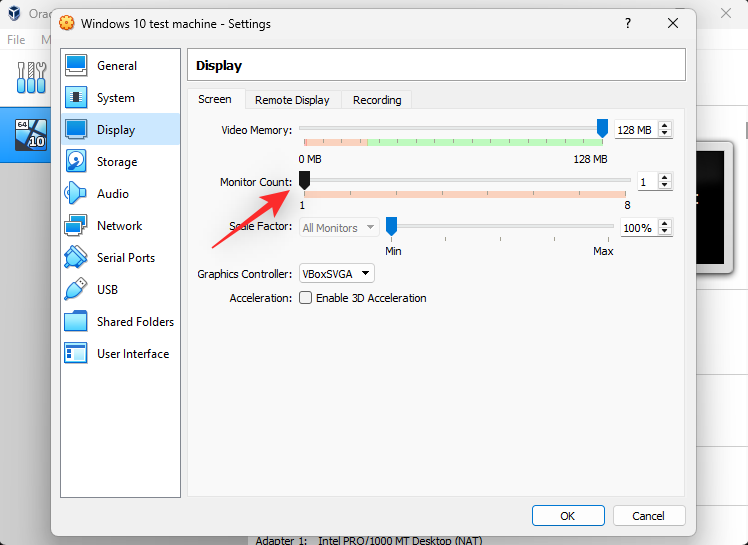
If you’re having scaling issues with your monitor, you can increase or decrease the same using the Scale Factor slider.
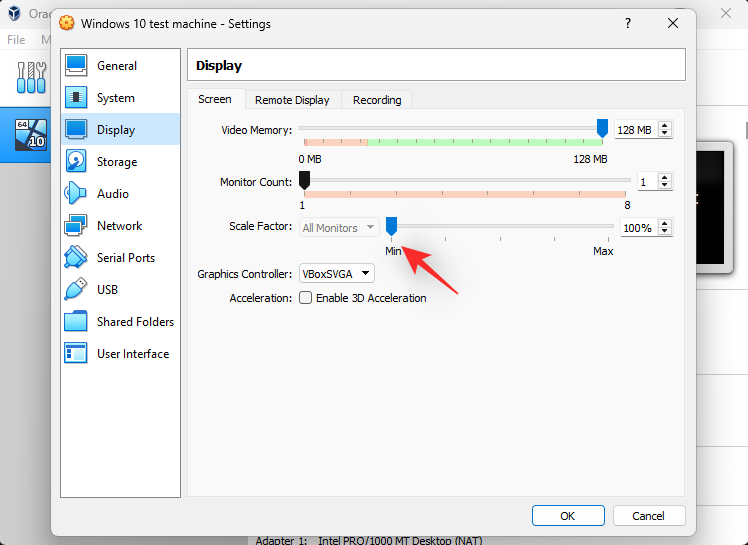
The Graphics Controller option allows you to change the type of graphics controller used by your virtual machine. Here are all the options and their recommended uses.
- VBoxVGA: This is the older emulated graphics controller with inferior 3D capabilities. It is recommended for older versions of VirtualBox and older versions of Windows released before Windows 7.
- VMSVGA: This is the newer emulated graphics controller with VMware SVGA 3D acceleration. It is the recommended choice for Linux users.
- VBoxSVGA: This is the same emulated controller as VMSVGA. The only difference is that hardware wise it reports itself with the same PCI ID as the VBoxVGA controller. This is the recommended graphics controller for modern versions of Windows.
- None: This will force VirtualBox to discard an emulated graphics controller. This is the recommended choice if you do not need a GPU or are using a dedicated GPU with a PCI pass-through to your virtual machine.
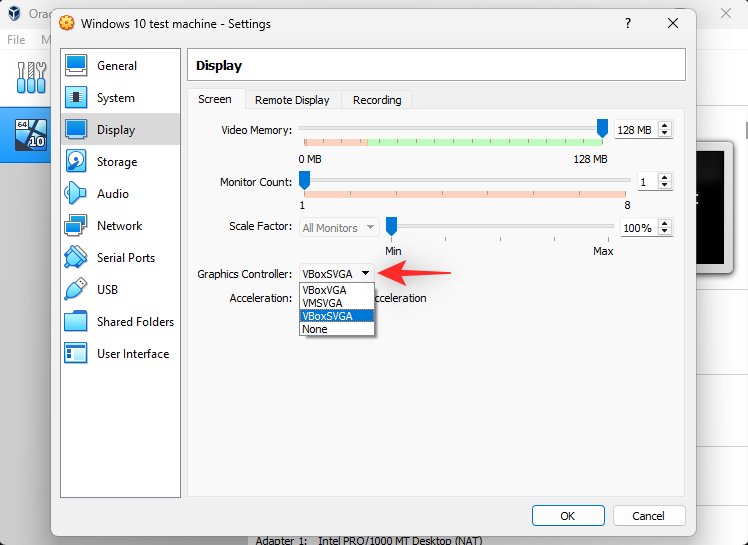
Now let’s get familiar with Storage options for your virtual machine. Click Storage on your left.
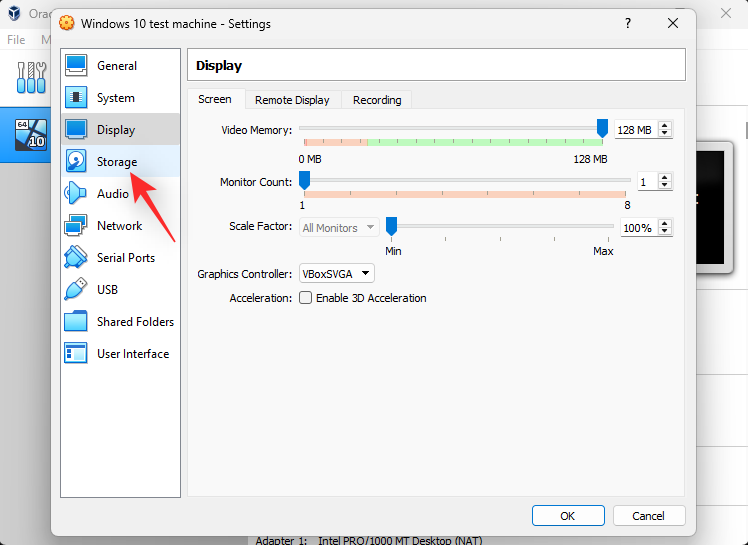
You can add additional storage controllers to your virtual machine using the icon at the bottom as shown below.
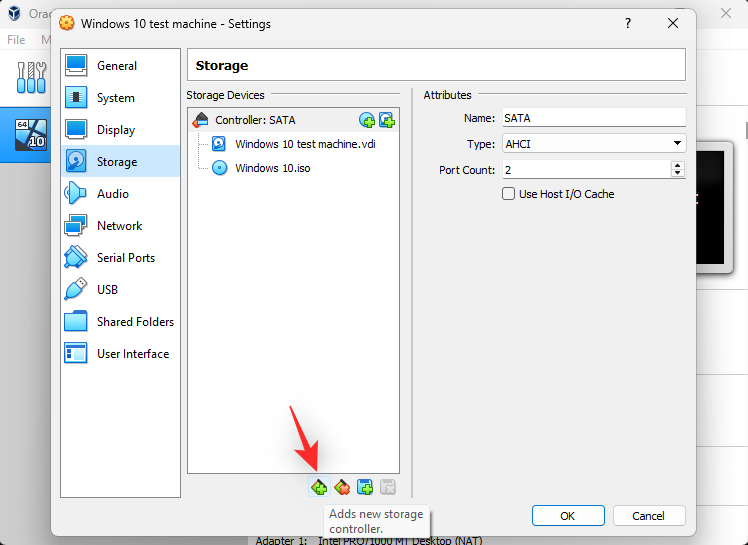
You can use the icon beside it to remove the selected storage controller.
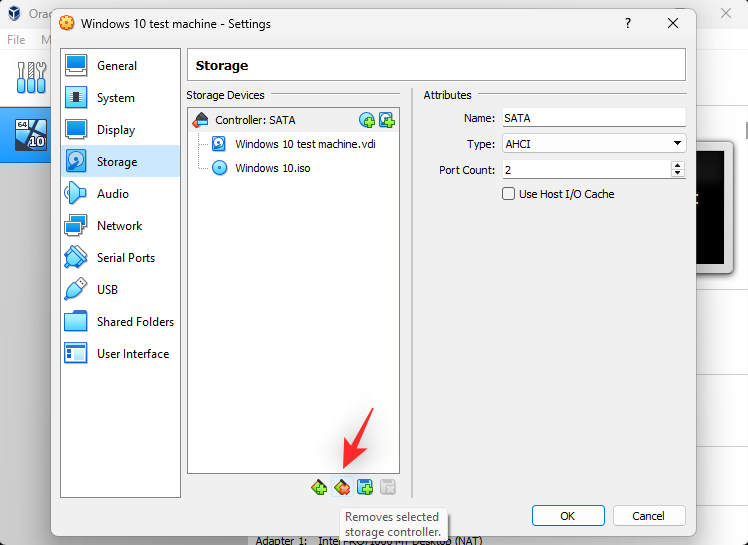
Now click and select a storage controller to view and add storage devices.
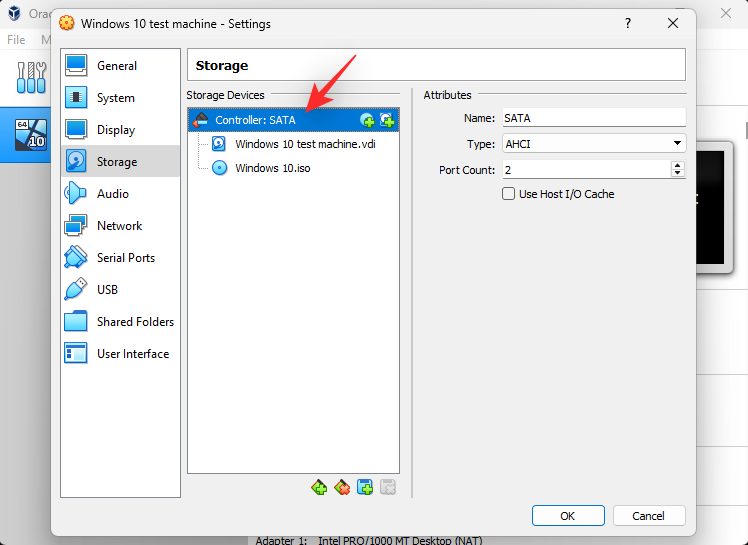
You can change the name as well as the ports offered by the controller on your right.
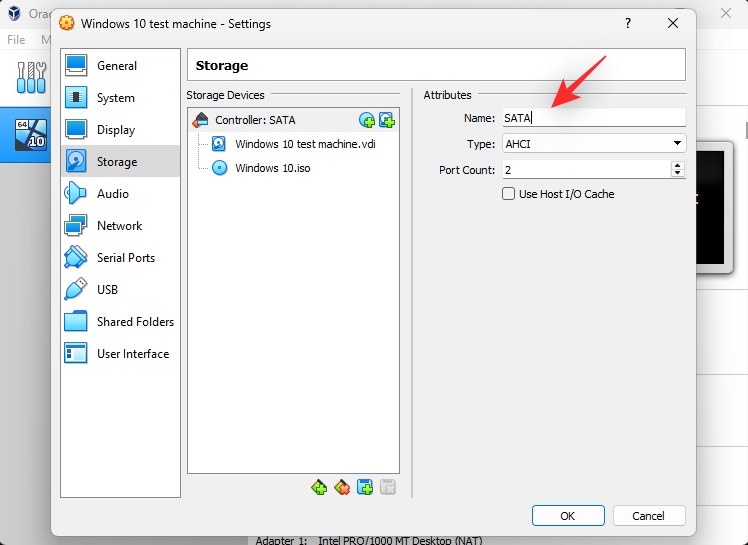
You can even change the type of storage controller detected by your virtual machine using the Type drop-down menu.
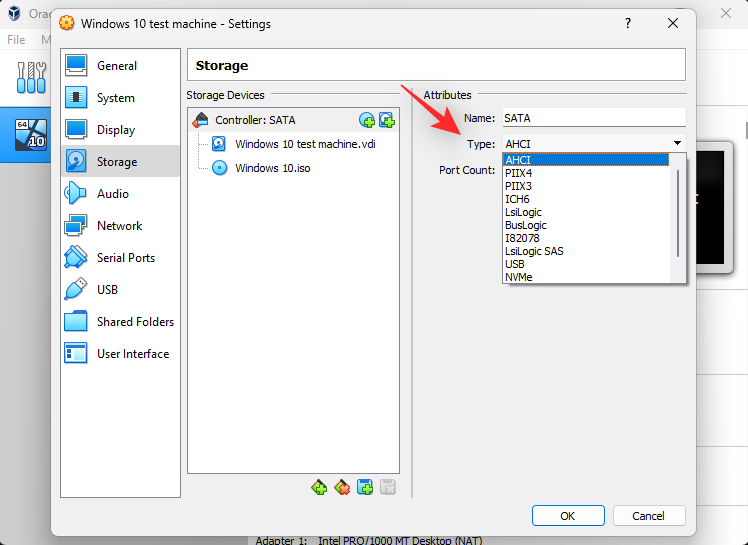
Similarly, click the Disk icon beside your storage controller as shown below to add a virtual disk to your machine.
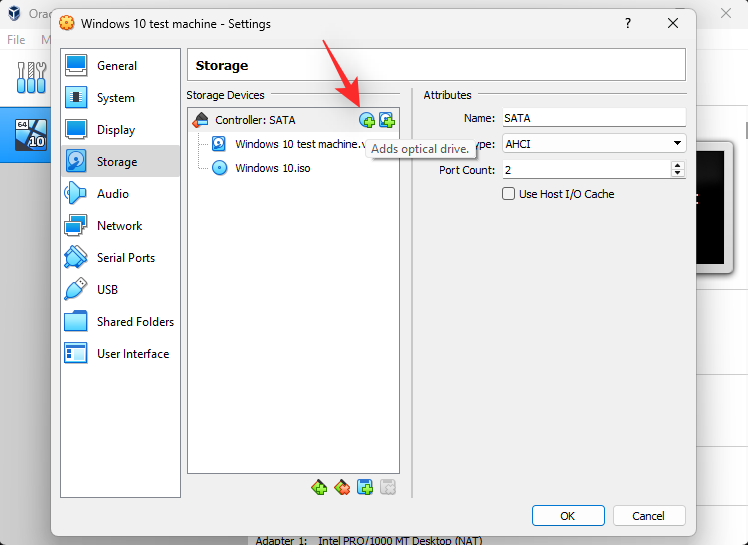
You can now mount an ISO to the same as we did earlier by using the Disc icon beside the assigned SATA port. Click the Drive icon beside your storage controller to add a virtual drive to your virtual machine.
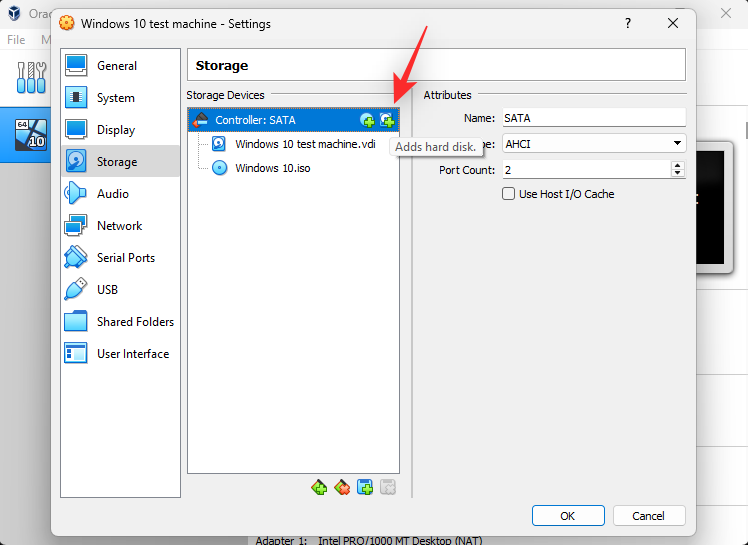
Click and select the same to view its customizable options.
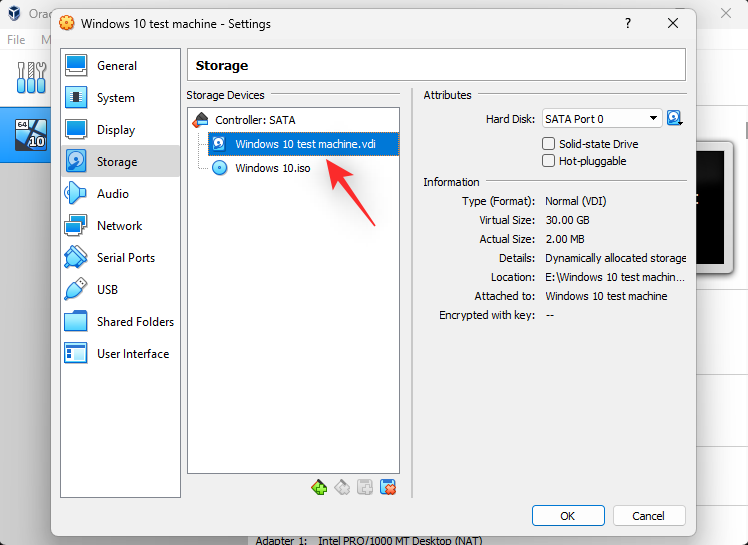
You can choose a new virtual drive using the Drive icon beside the assigned SATA port. You can also create a new virtual drive for your machine in VirtualBox itself using the same option.
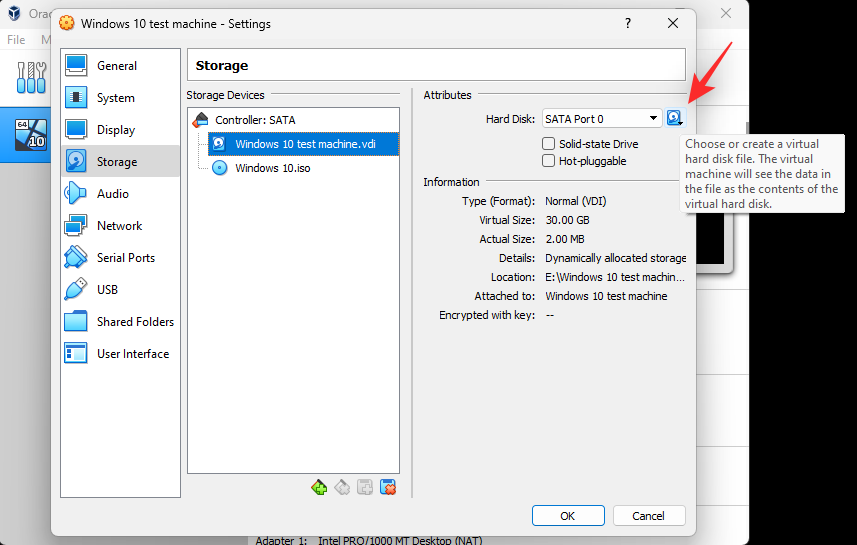
Check the following boxes depending on the type of Drive you wish to emulate in the environment.
- Solid-state Drive
- Hot-pluggable
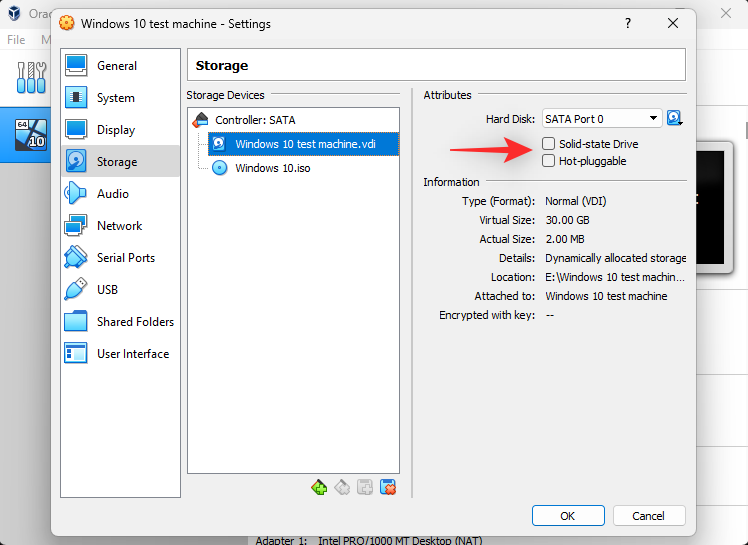
We can now move on and customize your machine’s audio devices. Click Audio on your left.
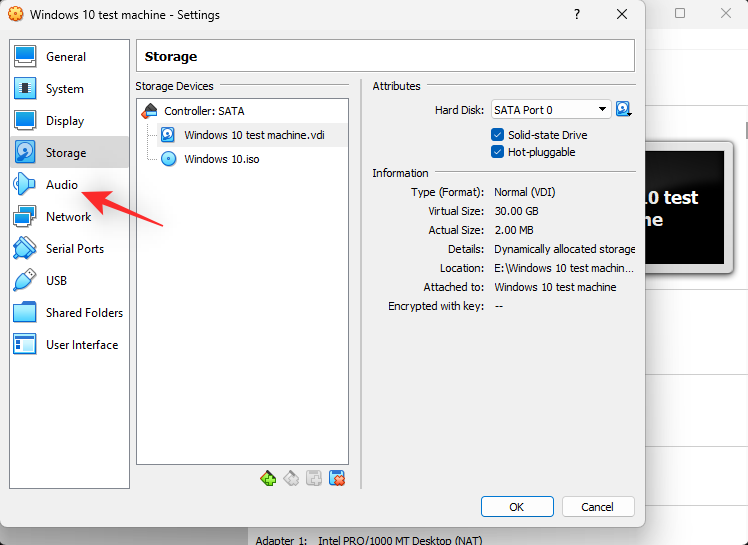
Check or Uncheck the box for Enable audio depending on your preferences.
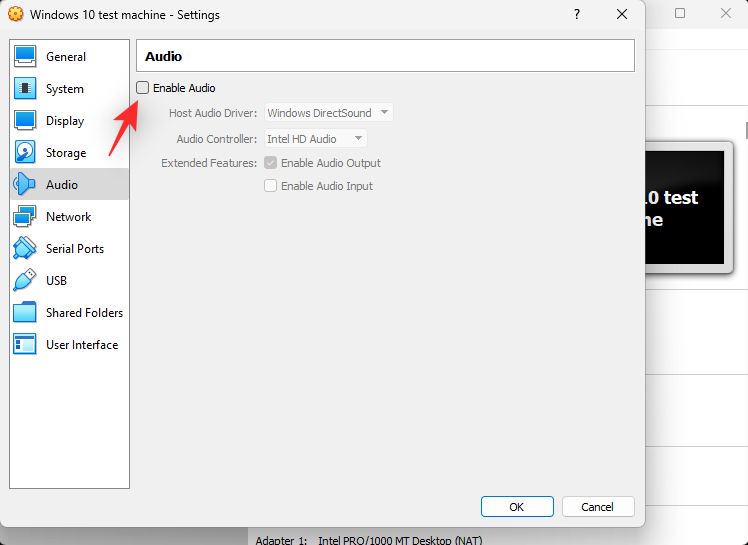
Click the drop-down menu for Host Audio Driver and select your audio driver.

Similarly, select your sound controller using the Audio Controller drop-down menu.
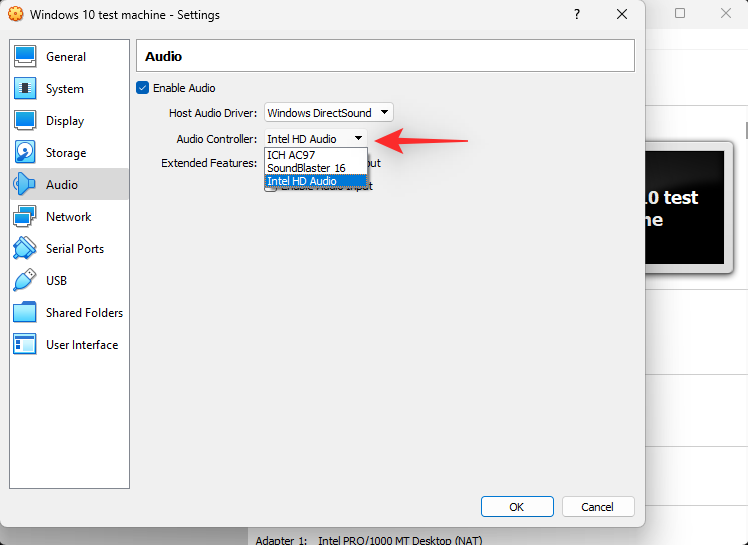
Check the following boxes under Extended features depending on your preferences.
- Enable Audio Output: This option will help enable audio output for your virtual machine through your default devices.
- Enable Audio Input: This will allow your virtual machine to access and use your audio input devices from your host machine.
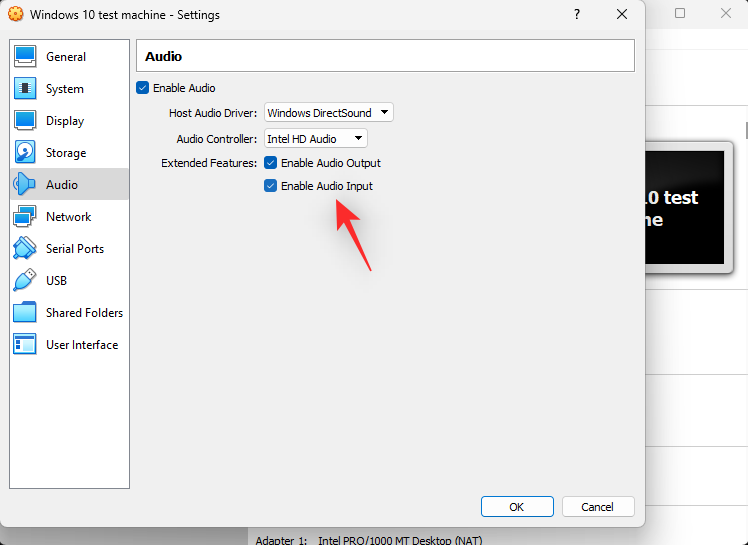
Click and select Network on your left.
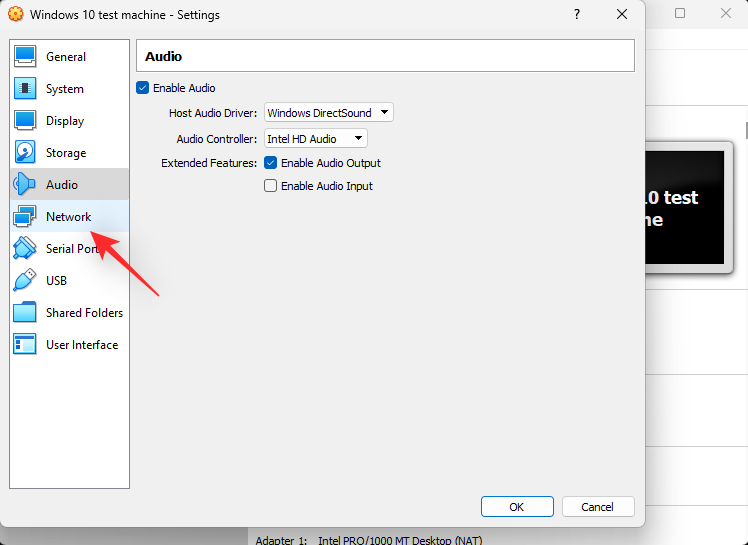
Check the box for Enable Network Adapter if you wish to use the selected adapter. You can enable multiple network adapters using the tabs at the top depending on your needs.
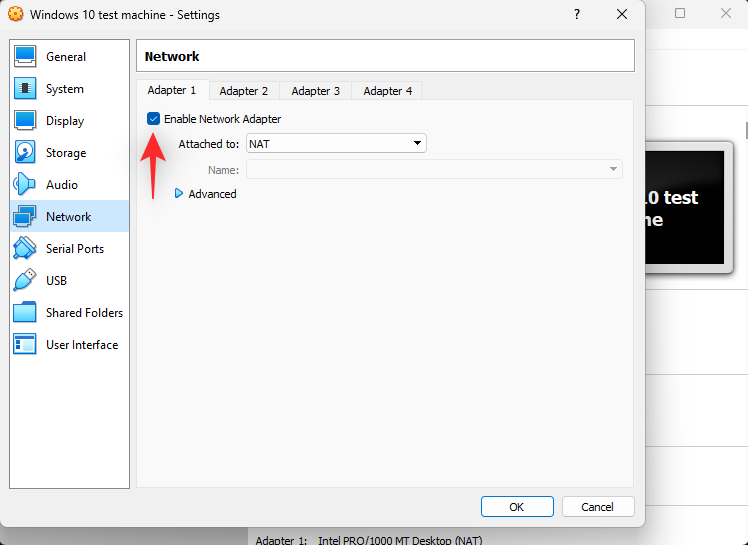
Now click the drop-down menu for Attached to and configure your virtualized network adapter as needed.
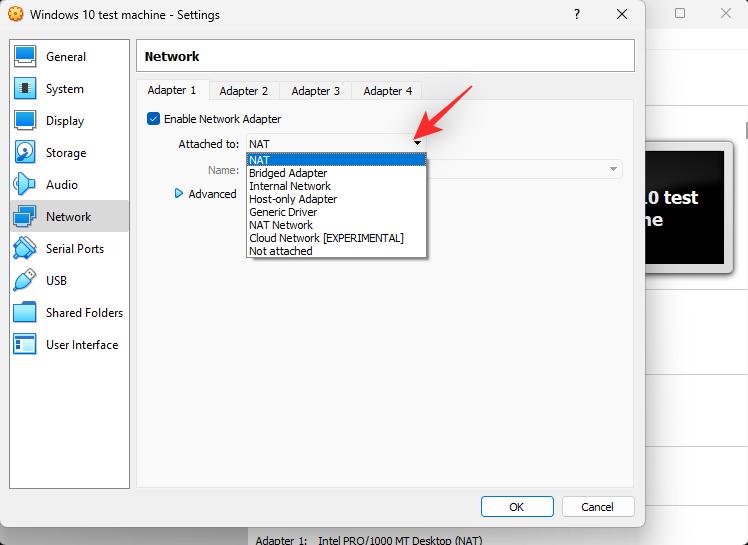
Click Advanced to configure additional settings for your network adapter.
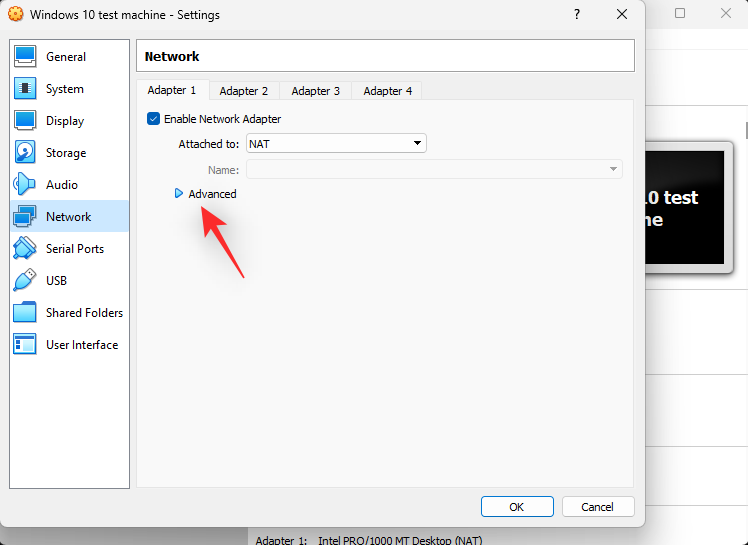
Click Port Forwarding and configure the same depending on your preferences if needed.
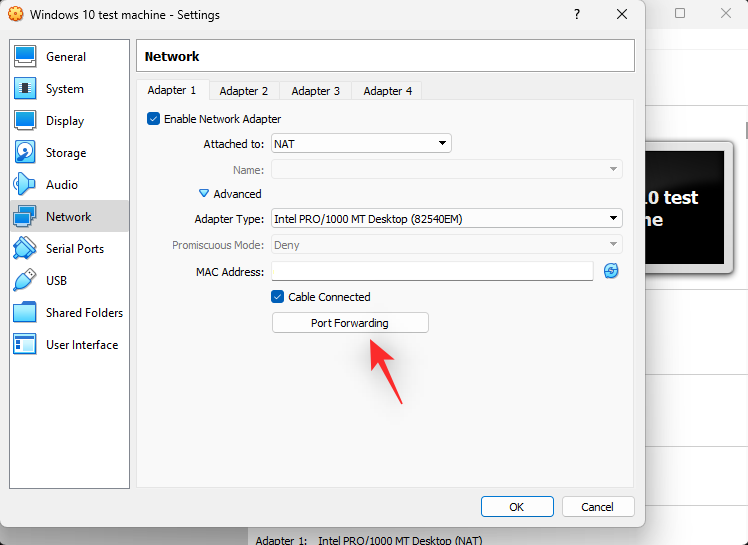
Click USB on your left.
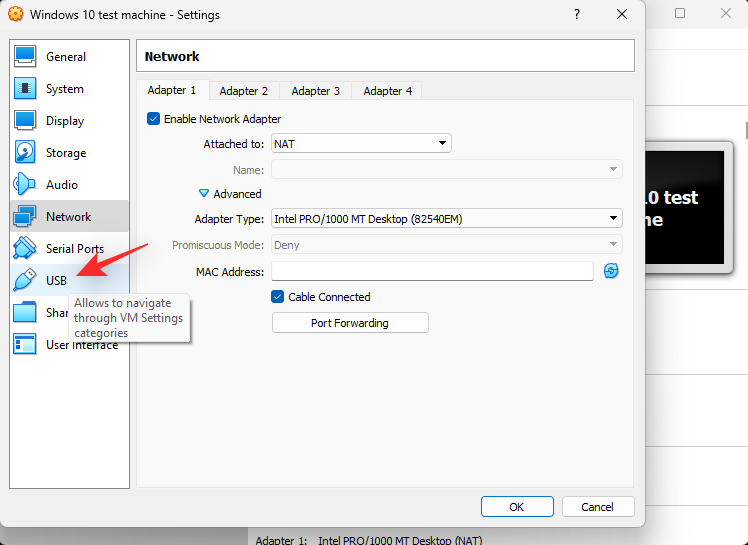
Check the box for Enable USB controller if you wish to use one with your virtual machine.
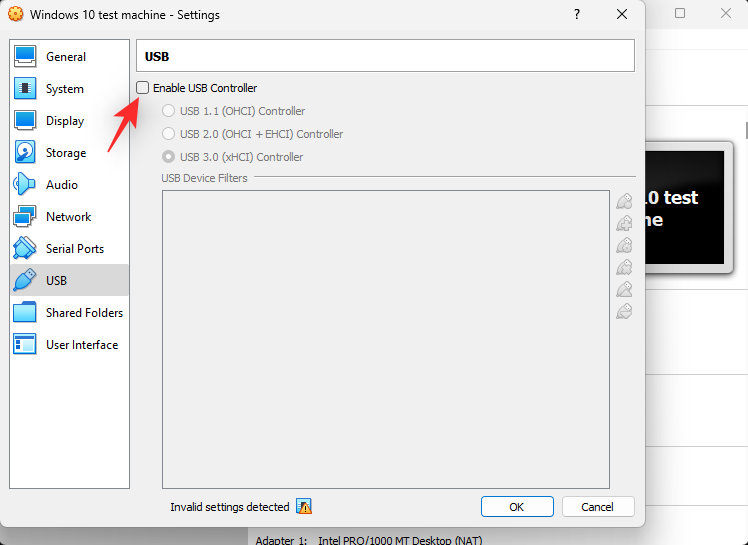
Now click the Add new USB icon on your right.
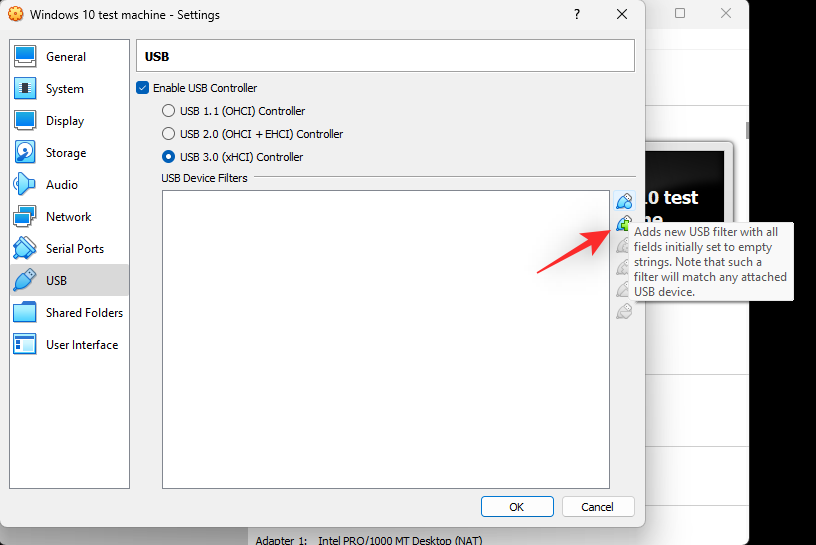
Select the desired USB device from the ones available on your host machine. Continue adding more USB devices as needed based on your current needs and the host machine’s setup.
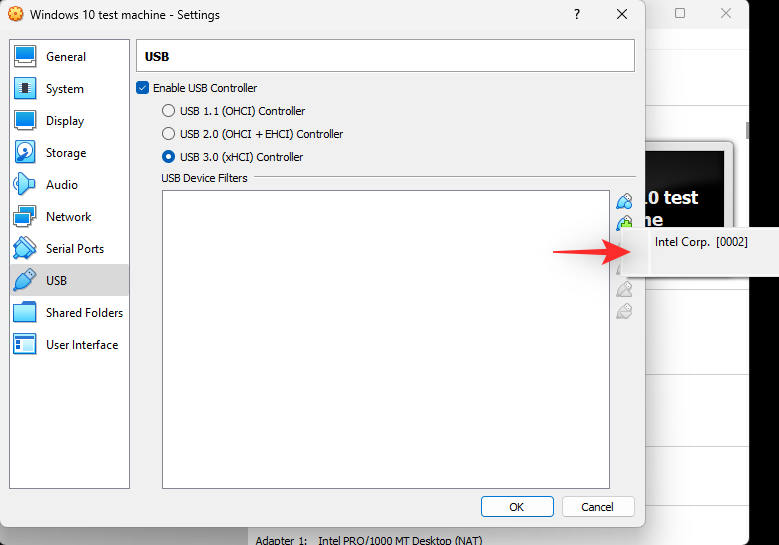
Finally, click OK.
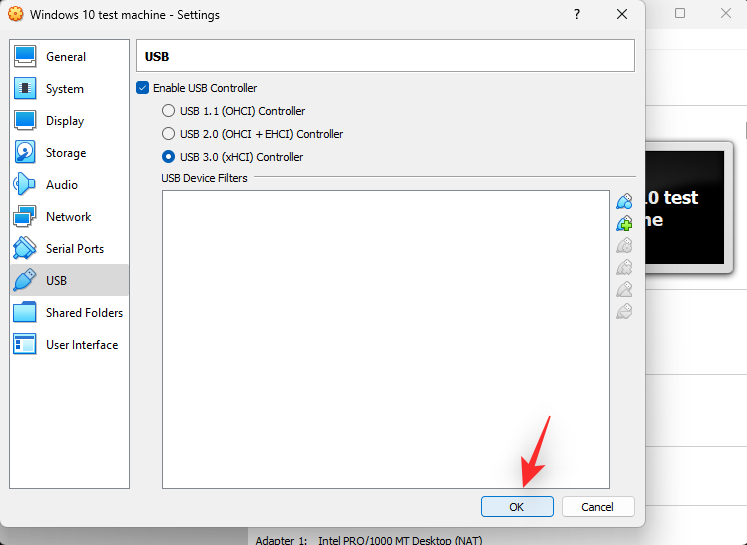
And that’s it! You will now have customized the resources for your new virtual machine in VirtualBox.
Troubleshooting: How to fix VirtualBox issues
Here are some common issues faced when setting up a new machine in VirtualBox. You can use the mentioned fixes to try and troubleshoot your issue accordingly.
Display issues
Display issues mainly occur due to incorrectly assigned Video Memory and Graphics controller. We recommend you verify and assign the correct ones based on your host machine and virtualized OS.
Storage issues
Storage issues occur due to incorrectly assigned storage controllers or an incorrect number of SATA ports. It could also be that your boot order is incorrectly assigned or missing the newer virtual drives and disks added by you. We recommend you verify the same in your virtual machine settings. Additionally, keep in mind that virtual disks might fail to show up depending on the OS if there is no ISO or disk image assigned to them.
Audio issues
Audio issues are a hit or miss when virtualizing depending on your hardware and its PIN configuration. We recommend you adjust your audio settings and add new devices based on availability. You can also try switching drivers or the audio controller.
USB 2.0 and 3.0 issues
USB support out of the box is limited when it comes to VirtualBox. USB 2.0 and 3.0 is unsupported unless you have installed the VirtualBox extension pack. Use the steps above to add the same to your setup. This will help introduce USB 2.0 and 3.0 support on your virtual machine along with the following features.
- Host webcam pass-through
- VirtualBox Remote Desktop protocol
- Disk Image encryption (AES)
- Intel PXE Boot ROM
FAQs
Here are some commonly asked questions about installing and setting up VirtualBox that should help you get up to date with the latest information. Let’s get started.
Can I transfer Virtual Machines?
Yes, VirtualBox easily allows you to export and import virtual machines between different hosts. Use File > Export Appliance or Ctrl + E keyboard shortcut to do the same.
What are snapshots in VirtualBox?
Snapshots are saved states of a VM that allow you to recover data or restore the machine to its Snapshot state. This can come in handy when making changes, testing code, or developing apps.
Can I use the same keyboard and mouse with my virtual machine?
Yes, you can use the same keyboard and mouse with your VM by default. Use the host key to switch between your host and the virtual machine easily. By default, Right Ctrl is your host key. You can easily customize this key using the VirtualBox preferences.
We hope this post helped you easily set up and use VirtualBox on your system. If you face any issues or have any questions, feel free to reach out using the comments below.
Table of Contents
What is VirtualBox?
If you want to run virtual machines (VMs) on your Windows 11 system, Oracle VirtualBox is a free, open-source, and cross-platform virtualization solution. It enables users to run multiple virtual machines on a single host operating system efficiently. VirtualBox is compatible with a wide range of platforms, including Windows, Linux, and macOS. It’s primarily designed for developers and IT professionals who need flexible and powerful virtualization tools.
Whether you’re experimenting with new operating systems, running older applications, or isolating development environments, VirtualBox makes it easy. It allows you to develop, test, showcase, and deploy solutions across multiple platforms—all from one machine.
In this guide, we’ll walk you through the complete process of downloading and installing Oracle VirtualBox on Windows 11. We’ll also walk through how to install the Oracle VM VirtualBox Extension Pack to enhance its functionality.
Prerequisites:
- A windows 11 PC
- Administrator access
- A stable internet connection
Step 1: Download Oracle VirtualBox
Open your browser and navigate to the official VirtualBox download page.

.
Under “VirtualBox platform packages”, click on Windows hosts to download the installer.

.
Save the .exe file to a known location (e.g., your Downloads folder). The Windows installer for Oracle VM VirtualBox 7.1.8 will begin downloading and should complete within a few minutes.

.
Step 2: Run the VirtualBox Installer
After the VirtualBox setup file has finished downloading, launch it to begin the installation process. Right-click the installer and select ‘Run as administrator’ to proceed.

.
Click Next to start the installation process.

.
Accept the license Terms and click Next.

.
In the next setup window, choose to install all available features. These include VirtualBox Networking (Bridged Networking), USB Support, Host-Only Networking, and Python Support. Installing the full package requires approximately 227MB of disk space. Keep in mind that each guest operating system you create will require additional storage based on its individual disk usage.
By default, VirtualBox will be installed in the C:\Program Files\Oracle\VirtualBox directory. If you’re low on space in your C: drive, you can choose a different installation path. In this guide, we’ll continue with the default location. Click ‘Next’ to proceed.
In the following setup window, all options are enabled by default. Simply click ‘Next’ to continue with the installation.

.
At this stage, a warning will appear notifying you that VirtualBox’s network features may temporarily disrupt your internet connection. Click ‘Yes’ to proceed with the installation.

.
Click Yes to add missing dependencies and proceed with Installation.

.
Click Next to continue.

.
At this point, the setup wizard is ready to begin the custom installation of VirtualBox. If you wish to review any changes, you can go back; otherwise, click ‘Install’ to start the installation.

.
The setup wizard will install all required files in your default installation directory. During the process, you’ll be prompted to install USB device drivers. Click ‘Install’ to proceed.
Next, it will update the system registry values and finalize the installation process.
Step 3: Launch VirtualBox Manager
Once the installation is complete, a dialog will appear on your screen. Check the box labeled ‘Start Oracle VM VirtualBox 7.1.8 after installation’ to launch VirtualBox immediately after the setup finishes. Then, click ‘Finish’ to exit the setup wizard.

.
The Oracle VirtualBox Manager will now open on your Windows 11 system.
Step 4: Install the Extension Pack
To add extra features like USB 2.0/3.0 support, RDP, disk encryption, etc.:
Return to the VirtualBox Downloads page.
Under “VirtualBox Extension Pack”, click Accept and download to download the VirtualBox Extension Pack file.

.
Go back to the Oracle VirtualBox Manager console. Navigate into the ‘Extensions’ tab.

.
Click on Install (+) symbol.

.
Locate the downloaded extension pack file ‘Oracle_VM_VirtualBox_Extension_Pack-7.1.8.vbox-extpack’ and click ‘Open’.

.
A dialog will appear in the VirtualBox Manager. Click ‘Install’ to add the Oracle VM VirtualBox Extension Pack.

.
Accept the license Terms and click I Agree.

.
A confirmation message will appear on the screen indicating a successful installation. Click ‘OK’ to proceed.
The installed extension packs will appear in the ‘Extensions’ tab of VirtualBox.

.
At last, Oracle VirtualBox is ready to use. You can now create a new virtual machine by selecting the ‘New’ option.

.
Conclusion
In this guide, we showed how to install Oracle VM VirtualBox along with the matching version of the Extension Pack on Windows 11. With everything set up, you can now create virtual machines and install various guest operating systems using customized network configurations. Thank you!
Post Views: 19
Oracle’s VirtualBox is a free virtualization application you can install on Windows 11 (or 10), Mac, and Linux to create and use virtual machines to run other versions of Windows or other platforms alongside the main operating system without the need to set up dual-boot or configure another computer.
Usually, you would use this virtualization technology to test pre-releases of Windows 11 available through the Windows Insider Program, run other operating systems like Ubuntu or Kali Linux, or create another virtual machine to test software without affecting your current setup.
VirtualBox has been designed to run on Intel as well as AMD hardware. While it is meant to be an enterprise product, it’s also available for home use with support for many guests operating systems, including Windows 11, Windows 10, Windows 8, Windows 7, Vista, and older versions, Linux (2.4, 2.6, 3.x and 4.x), Solaris and OpenSolaris, OS/2, OpenBSD, and many more.
In this guide, you will learn the steps to install and configure the basic settings to get started with VirtualBox on Windows 11 and Windows 10.
- Install VirtualBox on Windows 11
- Configure VirtualBox on Windows 11
- Install VirtualBox extension pack on Windows 11
To install VirtualBox on Windows 11, use these steps:
-
Open Oracle download page.
-
Under the “VirtualBox binaries” section, click the “Windows hosts” option and save the installers on the computer.
-
Double-click the VirtualBox-x.x.x-x-Win.exe file to launch the installer.
-
Click the Next button.
-
Click the Next button again.
Quick note: You don’t have to change the default setup settings unless you have specific requirements to install VirtualBox.
-
(Optional) Clear the options you do not want to use.
-
Click the Next button to continue with the VirtualBox installation.
-
Click the Yes button to confirm the virtual network adapter install warning on Windows 11.
-
Click the Yes button to install any missing dependencies (if applicable).
-
Click the Install button.
-
Click the Finish button.
Once you complete the steps, the software will finish the installation and launch automatically. You can also launch VirtualBox from the Start menu like any other application.
Installation with winget command
Alternatively, you can install VirtualBox using the Windows Package Manager (winget) in Command Prompt.
To install VirtualBox with the winget command, use these steps:
-
Open Start.
-
Search for Command Prompt, right-click the top result, and select the Run as administrator option.
-
(Optional) Type the following command to search for the name of the application and press Enter:
winget search virtualbox
Quick note: While the search command is not required, the install query must match the ID, name, or moniker of the package, which can change at any time. So, searching the application to execute the correct install command is a good practice.
-
Type the following command to install VirtualBox on Windows 11 (or 10) with winget and press Enter:
winget install Oracle.VirtualBox
After you complete the steps, the package manager will download and install the virtualization application without extra steps.
Configure VirtualBox on Windows 11
Although the default settings will suit more users, VirtualBox has many settings and features. In the steps below, we will outline some of the most basic ones everyone should consider changing when working with virtual machines.
To configure VirtualBox settings, use these steps:
-
Open VirtualBox.
-
Click the File menu and select the Preferences option.
-
Click on General.
-
In the Default Machine Folder option, specify the folder location to store the virtual machines on Windows 11. Usually, you want to use an external hard drive since using the primary drive can slow down the system.
-
Click on Update.
-
Select the Check for updates option.
-
Confirm the update settings and whether you want to use pre-releases of the software.
-
(Optional) Click on Display.
-
In the Maximum Guest Screen size option, specify the maximum screen resolution for virtual machines.
Quick tip: You can also select the “Hint” option to create a default maximum screen resolution. Usually, you want to leave the default settings and configure the resolution in the virtual machine settings.
-
In the Scale Factor option, select the scale virtual machines should use to make text and visual elements smaller or bigger.
-
Click the OK button.
After you complete the steps, the custom configuration will apply to the virtualization software.
Since the virtualization application configures NAT (Network Address Translation) automatically on each host you create, you do not need to configure the networking settings to get started. However, VirtualBox includes networking settings to create different host-only adapters and bridges, internal networks, and more.
Install VirtualBox extension pack on Windows 11
The extension pack is not a requirement, but it enables USB 2.0 and 3.0 devices, VirtualBox RDP, drive encryption, NVMe, and PXE boot for Intel Cards.
To install the extension pack for VirtualBox, use these steps:
-
Open Oracle download page.
-
Under the “VirtualBox Extension Pack” section, click the All supported platforms link to download the latest pack.
-
Open VirtualBox.
-
Click the File menu, select the Tools submenu, and choose the “Extension Pack Manager” option.
-
Click the Install button.
-
Select the “.vbox-extpack” file containing the extensions.
-
Click the Open button.
-
Click the Install button.
-
Scroll down the page.
-
Click the “I agree button to confirm the terms” option.
-
Click the OK button.
-
Click the OK button again.
Once you complete the steps, the Oracle VM VirtualBox Extension Pack will install on the device. Then you can proceed with the virtual machine creation and the Guest Additions installation.
If you want to remove it, select the package on the “Extensions” page, and click the Remove Selected Package button in the top-right.
Windows 11, the latest operating system from Microsoft, offers numerous exciting features and functionalities. One such feature is the ability to run virtual machines using VirtualBox. VirtualBox is a free and open-source virtualization software that allows users to create and run multiple operating systems in a single host.
In this blog, we will guide you through the step-by-step process of installing VirtualBox on Windows 11. If you are ready to have VirtualBox installed on your Windows PC, you can try installing Ubuntu 22.04 LTS on Virtualbox.
What’s New in VirtualBox 7.0?
VirtualBox 7.0 introduces several exciting features and enhancements. One significant addition is the support for Secure Boot in UEFI mode, enabling users to emulate TPM chips, which are mandatory for running Windows 11. Now, you can install Windows 11 on VirtualBox 7.0 without any issues.
In addition to the functional upgrades, VirtualBox 7.0 also includes subtle yet valuable design changes, giving it a fresh and modern feel. Some menu options have been relocated, but there’s no need to worry as the overall user experience remains intuitive and familiar. Furthermore, VirtualBox now offers a dark mode, allowing you to protect your eyes and enjoy a visually appealing interface.
Here is a step-by-step guide on how to download and install VirtualBox 7.0 on Windows 11. The installation process remains the same even if you have a different version of the Windows operating system.
1. Open the browser and search for the virtual box. Or, simply visit virtualbox.org to download the latest version of VirtualBox.
2. Now, to download, click on Download VirtualBox 7.0 and select Windows hosts from the platform packages to download it for the Windows operating system.

3. After the download is complete, open the VirtualBox installer file to install VirtualBox 7.0.
4. Now, in the setup wizard, click on the Next button.

5. Next, on the custom setup window, select the installation location where you want to install it. To do so, click on the Browse button and choose the desired location. If you don’t want to change it, you can keep the default location and click on the Next button.

6. Now, a warning window will appear titled Warning: Network Interfaces.
7. Click on Yes to continue. Don’t worry, it will not affect your Windows 11 operating system.

8. After that, the installer will notify you about the missing dependencies. Click on the Yes button to install them as well on your system.

9. Finally, your installation setup is completed. Here, click on the Install button to proceed with the installation process.

After that, wait for the installation process to complete. That’s it! This is how you can download and install the latest version of VirtualBox on Windows 11.
How to Install the New Extension Pack on VirtualBox
VirtualBox 7.0 comes with a new extension pack that enhances VirtualBox’s capabilities. The extension pack includes features such as VRDP support, host webcam passthrough, AES-encrypted disk image support, cloud integration, and more. Here’s how you can install it:
1. Visit the Oracle VirtualBox download page and download the VM VirtualBox Extension Pack. For that, visit this link: virtualbox.org/wiki/Downloads and click on the All supported platforms link.

2. Once the download is complete, open the VirtualBox app. Then navigate to File > Tools > Extension Pack Manager.
3. If you have any extensions installed, you have to uninstall them.
4. After that, you can install the new Extension Pack. For that, click on the Install button and select the downloaded file.
5. Then click on the Open button.

6. The VirtualBox extension pack installer will pop up. Here, click on the Install button.
7. Then read the license agreement and click on the I Agree button.

8. Once the extension pack is installed, it will appear in the list of installed extension packs. From there, you can conveniently connect USB devices, webcams, NVMe, and more to one or multiple virtual machines that you have created using VirtualBox.

Conclusion
By following the above-mentioned steps you can easily install VirtualBox 7.0 and the new extension pack on your Windows 11. Once it is installed, you are ready to use VM VirtualBox. If you are facing a resolution-related issue on Windows installation then you can install the Guest Additions files. For that, you can check out our guide on; how to fix Windows 11 resolution in VirtualBox.
That’s it, this is how you can download and install VirtualBox on Windows 11. We hope this article was helpful to you. Moreover, if you have any doubts regarding the installation process, you can ask them in the comments section below. We are always there to assist you.











